#although it's now considered a film noir classic
Explore tagged Tumblr posts
Text

May-June 1948. One of the most brutal Golden Age Batman stories is this bleak entry from WORLD'S FINEST COMICS #34, an atypically dark tale by Edmond Hamilton and Dick Sprang, about the rise and fall of a ruthless hired killer. Unusually, the story begins by revealing that the killer is already dead, an unidentified body on a slab in the morgue, and flashes back to his earlier life:
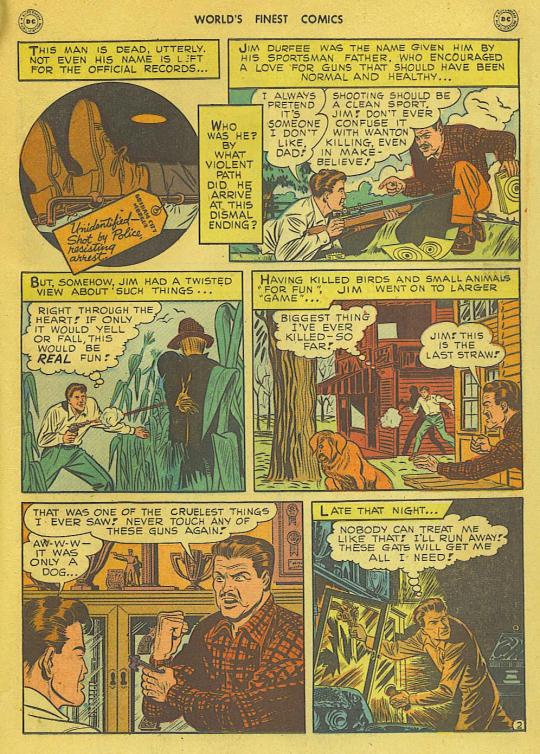
Even if you're willing to allow that Durfee's love of guns "should have been normal and healthy," the sadism and sociopathy on display here doesn't speak highly of the parenting skills of Jim's father. Yikes.
If you watch a lot of older film noir, this flashback sequence might seem somewhat familiar. I'm reasonably certain that it was inspired by a 1940 MacKinlay Kantor short story called "Gun Crazy," originally published in THE SATURDAY EVENING POST. About a year and a half after this story was published, Kantor and screenwriter Dalton Trumbo adapted "Gun Crazy" into the screenplay for a movie of the same title, directed by Joseph H. Lewis and released by United Artists in early 1950. "Gun Crazy" is also the story of a young man (called Nelson Tare in the original story) whose love of guns eventually leads to his destruction, although both the story and the film present their protagonist in a more sympathetic light than Hamilton does. As we soon see, Durfee is a monster:

Durfee decides to offer his services as a hired killer to gangster Pete Goro, being careful not to let Goro know his real name or even what he looks like. After completing several jobs for this new client, Durfee accepts a thousand dollars from another gangster to kill Goro, although to maintain his reputation, he still carries out his last commission for Goro: killing Gotham district attorney Tim Logan. Meanwhile, Batman, who has learned how Durfee's potential clients contact him, but nothing that would identify the killer, attempts to lure Durfee into the open by anonymously hiring him to kill Bruce Wayne!
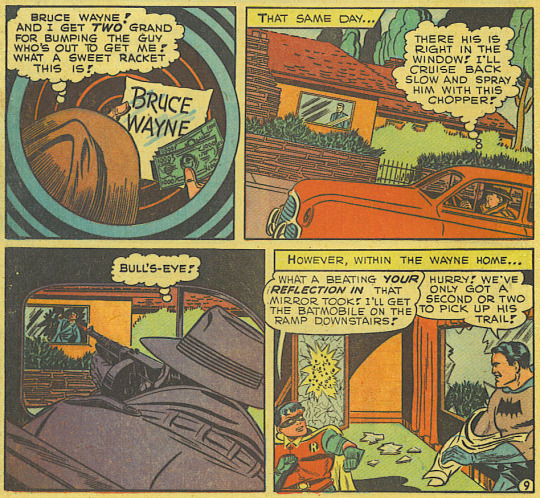
Batman and Robin are unsuccessful in capturing the wily assassin, but when Durfee realizes that he's failed to kill Bruce Wayne, his pride leads him to try again on the grounds of the newly opened county fair. Batman manages to decoy him with a Bruce Wayne dummy, but Durfee knocks Batman momentarily senseless with the wooden stock of his gun and loses himself in the crowd. Then:

So, Durfee is finally shot dead by a random cop who has no idea who he is, for a crime he hasn't actually committed. He then ends up buried in an anonymous grave, and even Batman never knows his real name. A very grim drama indeed, and a story that seems more suited to the gritty crime comics of the period, like CRIME DOES NOT PAY or Simon & Kirby's JUSTICE TRAPS THE GUILTY for Prize, than the relatively sedate WORLD'S FINEST. The cover of this issue, incidentally, sports this light-hearted Win Mortimer illustration of Batman, Robin, and Superman having fun:

(The other stories in this anthology issue aren't especially dark or violent, but it's still a little jarring!)
#comics#world's finest comics#edmond hamilton#dick sprang#mackinlay kantor#saturday evening post#movies#batman#bruce wayne#robin#robin the boy wonder#golden age batman#gun crazy#film noir#cw animal death#tw animal death#the film gun crazy was not well-regarded in its day#although it's now considered a film noir classic#this story is a great piece of work by dick sprang#it's less bouncy than his usual but the storytelling is very dynamic
31 notes
·
View notes
Text
Terrible Visions
A scrambled timeline is a timeline that has proceeded much like ours, except that some particular facet has been mixed up all over the place. For example, in the scrambled timeline we will consider today, our world's fictional stories have been told by different people, and in different ways.
Bryan Lee O'Malley, in this alternate timeline, is best known as the cartoonist responsible for Homestuck, a popular comic series about a group of children who become embroiled in a cosmic-scale video game known as Sburb. Although Homestuck is probably most often associated with the cult classic Edgar Wright-directed film adaptation released in 2016, the comics themselves are highly-regarded, and the film brought a new audience to them. Netflix has commissioned an animated continuation, The Homestuck Epilogues, which is due to be released soon.
Andrew Hussie, on the other hand, is a figure you're likelier to know if you're overly online. His "MS Paint Adventures" series - most notably including Scott Pilgrim Vs The World, which is kind of like Homestuck but weirder and hornier - have firmly remained a fixture of obsessive Twitter fandom culture. It doesn't help that the best-known iteration, Scott Pilgrim Vs The World, is infamous for stretching thousands of pages of meandering digressions out of a simple and focused narrative starting point. Scott Pilgrim fans have developed something of a toxic reputation, which is not entirely deserved - although of course Knives discourse is interminable, and back in the fandom's heyday there were reportedly incidents of fans assaulting each other "for being evil exes".
Scott Pilgrim fandom was very big back in the day, though, and consequently it was a nexus for other creative figures who would go on to surpass Hussie. Perhaps foremost among these is indie developer Toby Fox. He was literally living in Hussie's basement when he produced ROSEQUARTZ, a universally-beloved retro Goonies-like RPG about a human hybrid boy born to a race of gem-based aliens. He's now developing an episodic spiritual successor, RAZORQUEST, with more overtly dark themes. It revolves around an inheritance dispute among a demon-summoning family.
Other foundational figures in this timeline's internet culture include Alison Bechdel, who helped get the webcomic scene started. Although she's now more seriously acclaimed for her personal memoirs, her gaming webcomic Press Start To Dyke, which premiered in 1998, was once everywhere. It had a broad appeal, and at its height, it was common to see even straight guys sharing pages from it. Time has not been especially kind to it, though, and at this point its main legacy is test.png, a meme spawned by one of the comic's most ill-advised pages.
Then there's John C. McCrae, more often known by his pseudonym Wildbow. A prolific and reclusive author of doorstopping "web serials" - long-form fiction published online - McCrae's best-known serial is still his first, Wind, a noir superhero story set in an alternate history where capes are mostly just a subculture of unpowered vigilantes. Wind landed in a culture already rife with comic book deconstructions, like Alan Moore's 2002 graphic novel Worm Turns, but it nonetheless managed to stand out from the pack with its extensive cast of characters and its themes of coordination problems and the end of the world. Later McCrae web serials include Part (the first "Otherverse" serial; an urban fantasy story about a couple who die in a car accident and find that they have become ghosts), Tear (a "biopunk" story set in a collapsing underwater city), Warn (the controversial Wind sequel), and Play (the second "Otherverse" serial, set in a small Indiana town that helps hide a psychic girl from the CIA).
Last and perhaps least, we should discuss J. K. Rowling. Far and away the most famous of any of these authors, Rowling's name is inseparable from the YA series that she debuted with, the Luz Noceda books, which remain her one successful work. Although it was heavily derivative of older fantasy novels - like Jill Murphy's Academy For Little Witches, or Philip Pullman's Methods Of Rationality trilogy - Luz Noceda was still a monumental and unprecedented success in the publishing industry, and the film adaptations were consistent blockbusters. The final book, Luz Noceda and the Watcher of Rain, contained some allusions to a romantic relationship between Luz and her recently-redeemed associate Amity. Rowling confirmed that this was her intent in subsequent interviews and indicated that she had fought her publishers for it; the film would then go on to escalate matters slightly further.
There have been many lengthy and heated online arguments as to whether the references in the book itself constitute text or mere subtext. Whatever your stance on this discourse, a new complication has been introduced recently: although she has put out no official statement on the matter as of yet, it has become quite apparent from Rowling's shrinking network of contacts and her conspicuous silences that she is certainly TERF-sympathetic, and likely an outright TERF herself. For many, this is leading to a critical reevaluation of the social values inherent in the Luz Noceda series; others, to say the least, are holding off on that kind of reappraisal.
Anyway, Scott Pilgrim just beat Luz Noceda in a Twitter poll for Most Gay Media, and people are piiiiiiiiiiiiiiiiiiiiiiiiiiiiiiissed
649 notes
·
View notes
Text
Tagged by the esteemed @dying-suffering-french-stalkers to answer: a bunch of questions
Last song: "Slut like you" by P!nk. Why? Because it fucks
Last book: Last book I finished was Le Guin's A Wizard of Earthsea and yes it WAS my first ever delve into anything by Le Guin! Better late than never. Last book I picked up was Song of Achilles which I started a few months ago and then took a break cause it wasn't grabbing me. It's still kind of *hand wavy gesture* but it's definitely well-written and once you get past the first few chapters it moves quick
Last movie(s): JUST watched Girl Shy (1924) tonight but before that it was Scarlet Street (1945). Or (1946). It was definitely mid-40s.
Last TV show: Arcane season 2 back in November I think. I've been trying to rewatch the Twilight Zone but can't find it though I admittedly haven't been looking that hard
Last thing I Google searched: Aging Untouchable (hear me out meme reasons)
Favorite color(s): Gold/yellow, dark blue (BEST combo!!)
Sweet/savory/spicy: Hmmm I'm gonna say savory yeah though spicy CAN hit but I can only handle it in smaller amounts. Savory never gets old <3
Relationship status: *Talking Heads voice* Same as it ever was
Looking forward to: OUGH uh... huh. Naptime. My next movie foray
Current obsession: Been movie foraying since I lost my job and now have time to apparently watch every film on the face of the earth (which considering I'd seen like 2 movies prior to this year, is saying something). I've been maining film noir pretty hard though? I'm still limiting myself to Tubi for now but I have found other options to try since their selection doesn't have a lot of the really Classic(tm) "good" ones, although it has a few. Honestly though some of the B movies are really funny and surprisingly not bad. So far my list has been The Maltese Falcon (1941), The Third Man (1949), Dial M For Murder (1954), Kansas City Confidential (1952), New York Confidential (1955), Please Murder Me! (1956) The Woman in the Window (1944), Nightmare (1956), The Killing (1956), and Scarlet Street (1945). Honorable mentions to I Want to Live! (1958) which was marketed as a noir but I wouldn't really call it one, and The Lady Vanishes (1938) which I thought was a noir because I blind watched it and it turns out it wasn't, but it was good!
Tagging: YOU, reading this!
#also I AM taking movie recs. they don't have to be noir I'll watch anything but I cannot promise I will get to them in a timely fashion#or find them for that matter
4 notes
·
View notes
Text
Rooty Toot Toot - 1951, Dir. Jon Hubley
As I discussed in my previous post examining the interviews by Don Peri with Frank Thomas and Ollie Johnston, during the 1940's the Walt Disney Productions studio underwent a serious restructuring of goals and methods of animation. Following a contentious change in direction from a studio that was largely concerned with creating new kinds of entertainment through artistic experimentation, Disney began to focus more on consistently producing a more refined, realistic style of animation that would supposedly be more accessible to the average viewer. This coincided with the 1941 Disney Animator's strike, which by and large was concerned with uneven pay and practices at the studio which was a non-unionized workplace (although this was contested by Thomas and Johnston who believed there to be communistic ideals behind the strike). In retaliation to this strike (in addition to more underhanded tactics like allegedly hiring goons to break up picket lines and testifying against strikers in anti-communist hearings) Disney fired many of the animators, and although he was eventually pressured into allowing some of them to return by the Screen Cartoonist's Guild, others were disillusioned with the studio and instead left to pursue their own projects. The most notable of these is likely the highly influential independent studio known as the United Productions of America, or simply UPA.
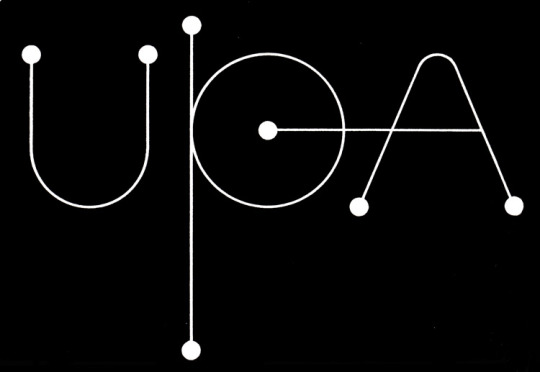
UPA logo, Alvin Lustig, 1947
UPA became known for its extremely stylized, exaggerated and sparse style. Intentionally stepping away from the standard "funny animal" characters that were at that time very common in animation, especially in Disney productions, UPA often instead focused on caricatures of humans that could be animated relatively quickly and cheaply in its limited animation style, similarly to another one of my previous posts, The Dover Boys. Although they were producing shorts as early as 1944, the studio's main animated successes were the series based around Mr. Magoo, a short-sighted elderly curmudgeon who repeatedly avoids certain death by sheer luck, and the popular theatrical short Gerald McBoing-Boing, a young boy who can only communicate in sound effects, the original story of which the short was based upon being written by Theodor Geisel, better known as Dr. Seuss.
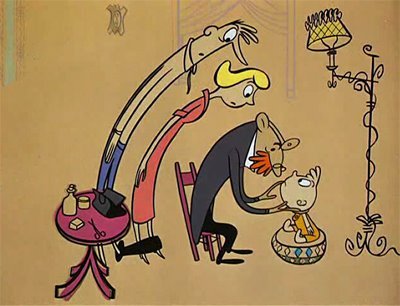
A screenshot of Gerald McBoing-Boing, featuring UPA's stylized human characters and sparse background art.
John Hubley, although not a founder of UPA, was one of its earliest employees and like many others of his ilk, was a former Disney artist who, while supposedly one of the better paid of the strikers, still felt limited by the artistic restrictions of Disney's mandates for realism. Despite the successes the studio had experienced so far, there allegedly existed a fair bit of animosity between the key artists working in UPA. Gerald McBoing-Boing won the studio an Academy award, and Hubley was eager to create a film that was equally influential. This led to the creation of UPA's most expensive and artistically ambitious cartoon yet, 1951's Rooty Toot Toot.

Poster for Rooty Toot Toot.
The short exudes a film noire vibe, its story being a retelling of a now over a century-old tune, Frankie and Johnny. A classic American murder ballad, the song details the murder of an unfaithful pianist by his jilted lover, and the film follows the song very faithfully. The story is presented as a musical courtroom drama, with the testimony of witnesses during the trial of Frankie as flashbacks to the events of the murder. Rooty Toot Toot is notable in animation for the time for the use of adult themes such as sex, violence, corruption, infidelity and ultimately, murder. Although these concepts were not unknown to the animation scene at this point (Fleischer cartoons, for example, often featured some of these concepts) it was still considered quite shocking for the time and as a result, Rooty Toot Toot was withheld from TV syndication for many years.
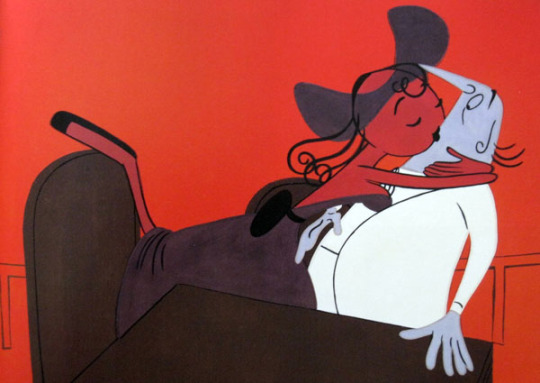
A screenshot of Rooty Toot Toot, featuring the short's highly exaggerated style and use of colour.
What really strikes me upon watching the short, however, is its unique art style. Even by UPA standards, Rooty Toot Toot is unique and experimental. Animated by, among others, Art Babbitt, the original creator of Goofy, and Grim Natwick, animator on Betty Boop for the Fleischer Brothers, the film oozes a Jazzy personality that really adds to the darkly comedic tone. Great care has been given to help establish personality through animation acting in almost every scene. Characters pirouette through their choreography in ballet-like motions (referenced, but not rotoscoped, from poses by dancer Olga Lunick), the put-upon bartender hunches with the weight of the cruel world on his shoulders, Frankie's sweet expressions are quickly replaced by barely-contained fury.

The backgrounds, made by Paul Julian, were created by taking a corroded gelatin roller to produced the distressed look of the dingy, sleazy setting. One thing that strikes me as particularly interesting; characters are often portrayed as "transparent", the bright colours of their garments or the background bleeding through their limbs in an almost cubist or modernist style. The linework is simplistic but clean and clear, and the strong posing really helps characterize the less-than-moral personalities of the story. I think overall it is not unreasonable to say that Rooty Toot Toot was the artistic peak of UPA's catalogue.
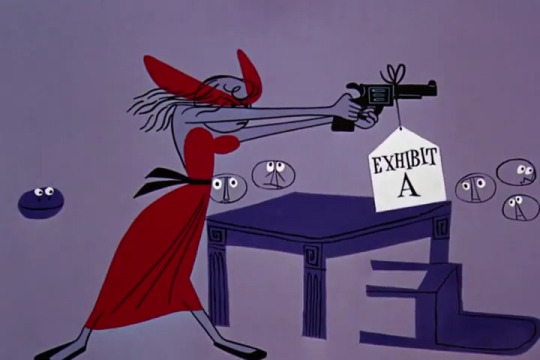
Frankie shooting down her attorney.
Unfortunately, not unlike Fantasia, Disney's own ambitious artistry-driven film, Rooty Toot Toot was not the smash success that Hubley had hoped for. Although it did receive an Academy award nomination, it would lose out to The Two Mouseketeers, a Tom and Jerry short. Worse still, not long after its release, the House Committee on Un-American Activities was informed that many of the artists working at UPA were communist sympathizers. Columbia sent a letter to UPA threatening to end the studio's distribution unless the named artists, including John Hubley, publicly denounced communism, and upon his refusal, Hubley was fired from UPA. From that point on the studio floundered and its artistic ambitions, despite its original attempt to distance itself from Disney, ultimately winnowed in the same way Disney's had after the failure of Fantasia.
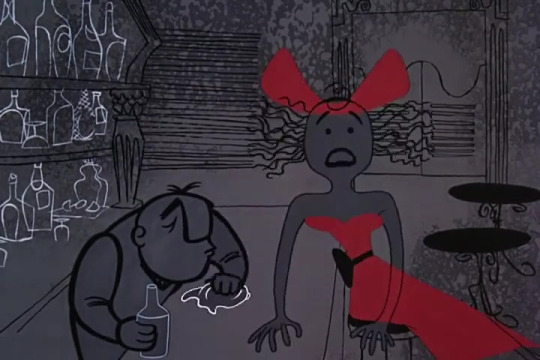
Today, the short is widely acclaimed as one of the most important pieces of independent animation from an American studio ever made. It was voted as one of the 50 Greatest Cartoons of All Time by industry professionals in 1994, and it is still used as a point of reference for animators for posing and personality. Even now, younger generations of artists are still taking inspiration from this extremely unique and engaging piece, over 80 years later.

References:
http://amodernist.blogspot.com/2012/06/rooty-toot-toot-1951.html
https://www.skwigly.co.uk/100-greatest-animated-shorts-rooty-toot-toot-john-hubley/
https://reedart.wordpress.com/2020/03/25/rooty-toot-toot-1951-upa-studios/
https://www.beyondeasy.net/2017/04/animation-april-rooty-toot-toot-1951.html
0 notes
Text
10 Best Movies on Amazon Prime to Watch Right Now

The ten Best movies on Amazon Prime to watch right now are the ones you've been looking forward to watching for months. This list is sure to inspire you to pick up the subscription service and start watching! We've listed the ten best movies on Amazon Prime right now based on reviews, and have included a short description for each.
Read on Best movies on Amazon Prime to get started! And while you're at it, why not watch all ten?
When it comes to recent critically acclaimed movies, Amazon Prime is a definite leader. If you're looking for an Oscar winner, there's no better place to watch it than on Amazon Prime. From classics to recent blockbusters, you'll be spoiled for choice! The selection of critically acclaimed films is staggering, too. If you're in the mood for a historical drama, there's a lot to choose from! If you're looking for something a little more exciting, try an action or adventure film. Something Wild is a great example of this. It begins as a classic boy meets girl story but turns into a darker tale when the girl's ex-husband gets involved. Another great choice is Rushmore, a Wes Anderson and Bill Murray comedy-drama that launched the career of Jason Schwartzman and established the latter as an art-house giant. If you haven't seen this film yet, it's a great way to get acquainted with the genre. Based on a 1939 novel, Detour stars Tom Neal and Ann Savage in a story that follows a classic noir structure. It was considered a lesser B-movie for years, but has only recently been recognized as an outstanding classic. The premise is simply riveting, and there is no way you won't be captivated by the story! Another great movie on Amazon Prime is "The Lighthouse" by director Robert Eggers. This atmospheric thriller stars William Dafoe and Robert Pattinson in a duet. It's a dark comedy, psychological thriller, and horror movie all wrapped up in one. While not all horror movies are as terrifying as The Lighthouse, "The Witch" director Robert Eggers has made a brilliant film that's worth watching now. If you're looking for a way to escape reality, science fiction and fantasy films are perfect for this. James Stewart plays a down-on-his-luck character in the 1946 Frank Capra classic. The film's title refers to the story of a young radio operator who hears a mysterious audio frequency. Although the film is an unsettling movie, the final result is an incredible tale about life, love, and friendship. "Titanic" is a James Cameron masterpiece. Starring Kate Winslet and Leonardo DiCaprio, Titanic is the ultimate love story before tragedy struck. This film's iconic lines, beautiful costumes, and climactic finale are sure to stir up any movie lover. So watch it and start enjoying some of the best movies on Amazon Prime right now. You won't regret it! Another period drama is Pawel Pawlikowski's "Cold War." This film takes place in post-World War II Poland, and follows the story of two young lovers who fall in love while on a road trip. The melodrama of politics and fate pulls lovers apart, but their love and friendship endure despite the odds. In a time of war, love is the best medicine. "The Handmaiden" is another intriguing movie on Amazon Prime. It stars Riz Ahmed as a heavy metal drummer and a deaf recovering addict. This thriller is brimming with sensual drops and a two-and-a-half-hour runtime. You'll feel like you're on a movie set during the Great Depression, and won't want to miss a moment of it. Read the full article
0 notes
Text
'One can consider Oppenheimer a groundbreaking film for various reasons. The blockbuster period-piece biopic not only shares an unsung story about one of history's most contentious physicists, but in the signature style of Christopher Nolan, it also presses boundaries of what cinema can do both visually and dramatically. The star-studded film offers stellar performances from the likes of Cillian Murphy, Matt Damon, Emily Blunt, David Krumholtz, Florence Pugh, and more. However, the most memorable performance may come from the world's favorite superhero actor, Robert Downey Jr., who plays against his conventional type to give us an unexpected and down-to-earth villain.
Robert Downey Jr. Is Hollywood's Haughty Hero
Although they might be snarky and sarcastic, Robert Downey Jr.'s characters almost always come off as heroes at the ends of their respective movies. Even when he's not donning a super suit to play Iron Man in the Marvel Cinematic Universe, RDJ has excelled at playing protagonists from Sherlock Holmes to Dr. Dolittle. Outside of blockbusters, he may take on more morally complicated roles, but whether he stars in a comedy like Tropic Thunder or Due Date, a drama like Chaplin or The Soloist, a neo-noir like Zodiac, or a mix of the three in Kiss Kiss, Bang Bang, Downey Jr. often finds himself winning over the audience's hearts before the credits roll.
In Oppenheimer, Downey Jr. portrays Louis Strauss: a trustee at the Institute for Advanced Study at Princeton, where the eponymous Dr. Robert Oppenheimer (Murphy) worked, and chairman of the Atomic Energy Commission after World War II. Through nonlinear editing reminiscent of Nolan's Memento and The Prestige, Oppenheimer almost becomes just as much Strauss' story as it does the titular scientist's. In between color scenes of Dr. Oppenheimer creating the atomic bomb during the War, black-and-white scenes show Strauss attending a hearing to join President Eisenhower's cabinet in the 1950s.
With a receding white hairline and thick glasses, Robert Downey Jr. is not immediately recognizable as Strauss. He appears far older than the actor's 58 years would suggest. Nevertheless, Strauss enters the film with reasonable levels of RDJ charm. In one of the first scenes, Strauss offers Oppenheimer a prestigious position at Princeton, and even as their differences unfold across the film's first and second acts, Strauss still upholds an image as one of the scientist's allies. It's not until the third act that a classic Nolan twist turns the character on his head and reveals his true, conniving nature.
What Makes Robert Downey Jr. 'Oppenheimer' Performance Strong?
Unbeknownst to the audience for nearly two hours of the film's colossal 171-minute runtime, Strauss is secretly the villain in Oppenheimer. Near the start of the third act, as his hearing breaks for a recess, Strauss reveals to his senate aid (Alden Ehrenreich) that he has covertly been pulling strings to undermine Oppenheimer for political gain. Throughout the film, several scenes depict Oppenheimer being aggressively interrogated about his left-leaning, former-Communist affiliations in conjunction with his stances against the United States developing a Hydrogen Bomb. In this pivotal scene, Strauss reveals that he not only orchestrated the interrogation but rigged it against Oppenheimer to ensure that the scientist would lose his security clearance to the Atomic Energy Commission.
Robert Downey Jr. plays this switch masterfully. Just as Strauss has all of his colleagues fooled, RDJ effectively tricks the audience into thinking he was one of the story's good guys. However, once Strauss reveals his true nature and ambitions, all of the subtleties in RDJ's performance rise to the surface. Throughout the scene, he remains cool, calculated, and precise, and yet, we now notice the hints of furious self-absorption that Downey Jr. has been building within the character all along.
Why Does Robert Downey Jr. Work So Well as Strauss?
Robert Downey Jr. in OppenheimerImage via Universal Pictures The atypical casting of Robert Downey Jr. as Strauss makes the twist even more rousing. Unlike Tony Stark or Sherlock Holmes, Strauss never comes off as the smooth-talking maverick that RDJ often portrays. Even before the curtain falls on his agreeable facade, Strauss is somewhat distant in Oppenheimer. He appears as an uninspiring bureaucrat, rarely filling the room and hardly a centerpiece in the film. For a good chunk of the movie, it seems like the character is just there to frame Oppenheimer's story without consequence. It's a far cry from RDJ's usual roles as suave, eccentric bigwigs, and it adds to the twist's chilling effect.
As aforementioned, RDJ is best known for playing protagonists, and yet Strauss' character arc is almost the reverse of Tony Stark's in the first Iron Man movie. In the 2008 superhero film, Stark enters the narrative as an openly conceited hothead, but by the end, he rises to become a selfless hero. By contrast, Strauss begins Oppenheimer as a likable figure but ends with his pride and arrogance flatly displayed. It is not layers of hubris peeled back to reveal virtue, but quite the inverse, and while Iron Man eventually saves the world in The Avengers, Oppenheimer's haunting denouement suggests that Strauss contributed to its destruction.
Robert Downey Jr.'s 'Oppenheimer' Role Showcases His Impressive Range
All of this — from RDJ's anti-typecasting to Strauss' layered identity — not only proves that Robert Downey Jr is more than a character actor, but it demonstrates that he has a talent for nuanced and complex roles... enough so to pull off a Christopher Nolan plot twist without the narrative assistance of time travel, wormholes, or nineteenth-century magicians.
Above all, though, it confirms that Downey Jr. can play the villain just as well as he can play the hero. After nine times portraying Iron Man, and only once getting to dip his toe into antagonistic waters when becoming the adversary in Captain America: Civil War, RDJ finally showcases his chops for playing a cold, conspiring, and (eventually) unambiguous bad guy in a movie. While we'd all love to see Robert Downey Jr. further demonstrate his range and take on additional roles in serious movies like Oppenheimer, we can't help but feel inspired by his villainous portrayal of Strauss, and question if there might be a supervillain role in the actor's future.'
#Oppenheimer#Robert Downey Jr.#Lewis Strauss#Cillian Murphy#Christopher Nolan#Matt Damon#Emily Blunt#David Krumholtz#Florence Pugh#Tropic Thunder#Sherlock Holmes#Dolittle#Chaplin#The Soloist#Memento#The Prestige#Alden Ehrenreich#Captain America: Civil War
1 note
·
View note
Text
a/n: I was listening to more Dua Lipa and I thought to myself “wow Mista would like a lot of these songs” and it just. spiraled from there lmao. these are headcanons that I’ve referenced in previous works, plus some new ones. I also wanted an excuse to talk about 90′s / y2k stuff so..... here are some miscellaneous headcanons about ya fav boys!
tw: mentions of Giorno and Fugo’s backstory
❥ ┋ ❝ random bucci gang headcanons!
bruno bucciarati.
the most fashionable out of the group. he’s not afraid to try daring fabrics and clashing patterns. although he dresses like a Gucci model, Bucciarati hates luxury brand name clothes. it’s such a gross display of wealth. and as someone who grew up in a lower-middle class home, he doesn’t understand why anyone would spend more than 100 euros on a shirt.
Bucciarati doesn’t like sleeping in. he feels like he’s wasted too much of the day if he wakes up past 10 AM. as a result, he tends to wake up somewhere around 5 AM every morning. part of it is out of habit as a fisherman’s son, part of it is being a workaholic. he spends his morning completing paperwork, but if there isn’t any to do, he’ll take a walk around Naples.
he’s the biggest movie fiend behind Mista. although there are some serious films that he really likes, such as Reservoir Dogs, dumb action movies are his guilty pleasure. Water World and Judge Dredd are so fucking awful yet he can’t help but love them.
leone abbacchio.
he’s the one everyone goes to when they need a disguise. Abbacchio knows exactly how to contour your face so that you’re barely recognizable. likewise, he’s really keen on how certain people dress. he can put together an outfit perfect for a masquerade party or infiltrating a construction zone.
Abbacchio is actually quite paternal around the younger members like Narancia and Fugo. kind of like an asshole older brother. he’ll tell them not to do fuckshit, but won’t stop them if they won’t listen. likewise, he’s there to offer an ear if they need it (even if he’s not the best at comforting).
I’ve said it once and I’ll say it again!! Abbacchio is a really good cook. his nonna taught him everything he knows. she’s since passed, so he cooks as a way to feel closer to her and provide for the team. although he likes healthy dishes the most, he tends to make fatty savory foods since that’s what the team likes.
giorno giovanna.
he’s always the last to get jokes. sometimes Fugo will have to explain it to him, but most of the time Giorno will just laugh along with the group to feel included. it’s only recently that he’s been able to let his guard down (especially considering his home life). even if he doesn’t understand the joke, he’s just happy to see everyone smiling.
he’s the first to offer praise to his teammates. despite his stoic exterior, Giorno wants everyone to feel included in what they do. some take it as sarcasm due to his blunt way of speaking, yet he means everything that he says.
Giorno has a sweet tooth, especially for chocolate treats. chocolate pudding may be one of his favorite foods, but he’s fond of anything he can get his hands on. and it doesn’t matter of it’s dark (though dark is his favorite), milk, or white — he likes��‘em all. he just hates Hershey’s chocolate. the way it just disintegrates on your tongue... eugh.
guido mista.
surprisingly, Mista’s the most religious out of the group. he’s not the typical God-fearing Catholic, though he was raised in that household. he'll mumble a small prayer before a particularly dangerous mission, but he stopped going to Mass after joining Passione. he doesn’t feel like it’s his place as a mobster to go.
he’s the biggest pop culture fiend in the group. he loves celebrity gossip, reading movie trivia, and catching up on the latest buzz around the newest episode of 90210. he doesn’t really care about the genre or celebrity, he likes learning about everything. (just don’t bring up that time he bawled at Titanic’s ending. it’s a sore subject.)
on that note, Mista loves to read. he prefers tabloids, but he’ll read whatever helps to pass time between missions. he likes crime noir fiction the most, followed by thrillers. if he’s going to read a book, he wants to be enthralled by it.
narancia ghirga.
while Mista’s the champion of movie / tv and celebrity knowledge, Narancia excels at music trivia. he can go on and on about Tupac and Biggie’s rivalry if you’ll let him. he’s best at hip hop history, but he’s knowledgeable on most genres (he’s not a fan of classical or country).
because of his interest in hip hop, Narancia’s trying to get more into poetry. Fugo’s having him read Shel Silverstein as an introduction. so far Narancia thinks a lot of it is boring, but there are a few that he enjoys. the poem Masks hit him a little too hard.
despite his lack of academic knowledge, Narancia is the most socially-aware out of the group. he’s really in tune with what the others are feeling. he can tell when someone is pretending to be okay with ease. while some may say that it’s a result of growing up the streets, he’s always been like this. he’s just an empathetic guy.
pannacotta fugo.
Fugo’s way of dressing is heavily inspired by Bucciarati. Fugo respects him a lot, so he tries to emulate him whenever he can. he was actually quite self-conscious of his swiss cheese suit. yet Bucciarati told him to try one thing that scares him every day and... it just stuck.
he goes by his last name because there are too many negative memories associated with his first. he can still remember his mother cooing “my little strawberry” at him. he’ll never forgive either of his parents, so using his last name helps him move on from his past.
Mista frequently pesters Fugo to trade books with him, though Fugo isn’t too keen on it... mostly because he thinks Mista’s taste is trash he’s not interested in whatever Mista’s reading. Fugo’s more of a classics guy. that changed when the gunslinger let him borrow Wiseguy (the inspiration for Goodfellas). Fugo trusts him a little bit more now. just a little.
#jjba#jojo's bizarre adventure#bucci gang#giorno giovanna#pannacotta fugo#bruno bucciarati#leone abbacchio#guido mista#narancia ghirga#golden wind#headcanons#no reader#long post#also I'm aware that this is a VERY American view of their likes / dislikes / hobbies#tbf tho.... the US has shaped a lot of pop culture 👀#anyway#I hope u enjoyed another edition of my late night ramblings 🌚
228 notes
·
View notes
Text
In Honor of Bogey
Born on Christmas Day at the turn of the century, the acting legend Humphrey Deforest Bogart is considered the greatest male acting icon of the Golden Age of Hollywood. He was an early Christmas gift to the 20th century and eventually was recognized by the AFI as the greatest male star of classic American cinema. This is quite a title to hold with all the great actors of the last one hundred years, so I wanted to take a little space in my analysis of the AFI top 100 to recognize this acting icon.
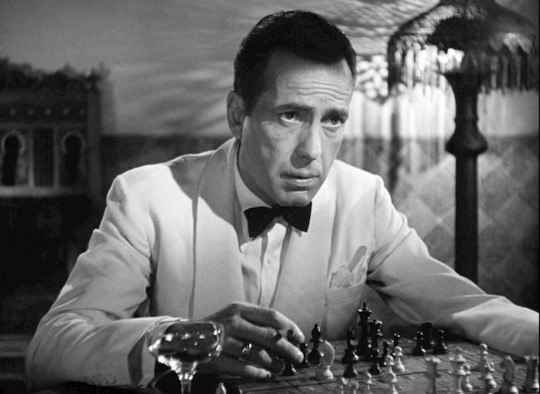
He was a kid with a lot of potential and intelligence, but his parents were not very affectionate (according to him) and he grew up with a chip on his shoulder. He went to some prestigious East Coast schools but was expelled or left on many occasions and ended up in the Navy. He joined up following the end of WWI and was part of the time of American Military glory. He loved it. He even tried to re-enlist when WW2 broke out, but he was too old and was instead registered as a volunteer reserve with the Coast Guard. He didn't get started in films until 1930, but started stage acting after his naval service in 1921. He might have gotten his trademark scar on his lip while in the Navy, but he got in a lot of scraps so it is not really certain where it came from.
Scars aside, Humphrey Bogart was a very good looking person that just exuded the ideal of manliness for the time. He started playing roles of young impetuous men and moved on to gangsters and villains. He did some work with James Cagney in a film called The Roaring Twenties. He met many woman with his star power and brutish manliness, marrying 4 times over his life before finally settling down with the fabulous Lauren Becall in 1945. He was part of the famous "Rat Pack" of the 50s. He was just so cool.
Since this is part of the AFI top 100 review, I want to cover the four movies on the list he was in as well as a couple other American classics:
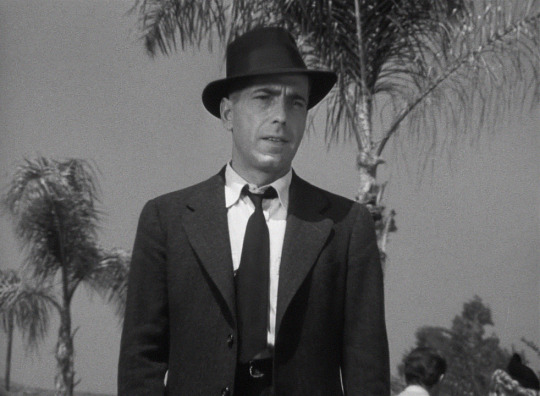
High Sierra (1941) - Nominated for AFI Top 100 but not ranked
This was a big opportunity for Bogart because it was a leading gangster role written by his drinking buddy John Huston. The part had been turned down by some of the great actors of the time, including James Cagney. Bogart had been getting a lot of small roles and appeared in as many films as he could at the time (he is credited in 20 movies between 1937 and 1939), but this was a big break as a leading man. He worked alongside Ida Lupino, which caused jealousy issues with his wife at the time, Mayo Methot.

The Maltese Falcon (1941) - AFI #31
This was a career starter for Bogart as the no nonsense anti-hero with a chip on his shoulder and a heart of gold. This film was also turned down by other more established leading actors (George Raft) because it was a remake of the same story that was done in 1931. He played the part of Sam Spade (great name), a detective in search of a bejeweled object while getting in way over his head. Bogie had a great smoky voice and his film noir narratives set the standard for the genre. It was also the directorial debut of John Huston. Humphrey Bogart was known for downplaying his work (such a hipster), but this was a film for which he openly showed pride.

Casablanca (1942) - AFI #3
This was Bogart's first real romantic lead as an expatriate in Africa at the outbreak of WWI. As far as my generation is concerned, this is his most famous role and cemented the man as a Hollywood icon. This movie won Best Picture and got him nominated for Best Actor, vaulting Bogart past James Cagney as the highest paid actor in Hollywood at the time (half a million a year; that is nothing to sneeze at now much less right after the Great Depression).

The Big Sleep (1946) - Not on AFI Top 100
This was arguably the most well known of the four movies that Bogart starred in with Lauren Bacall. His wife at the time, Methot, was jealous and was afraid that Bogart was cheating on her. He was. He and Methot got a divorce and he almost immediately married Bacall. Bogart also got a little bit weird at the time because he tried to sign up for the Navy and then bought a yacht, allowed use of it by the Coast Guard, and then patrolled around the California coast with numerous weekends around Catalina. The film was actually scheduled to be released in 1945, but had a bunch of scenes of sexual innuendo added in to play up the real life relationship of Bogart and Bacall.

The Treasure of the Sierra Madre (1947) - AFI #38
This was a film that showed the genius of Huston's writing and Bogart's acting. It was a chance to for Bogart to show off his grittiness and willing to suffer for his art. He character was one of three greedy men with stake on a gold claim that was more than enough for all three, but constant fear of backstabbing (literally and figuratively) causes problems. The movie was filmed in the Sierras during the summer heat and Bogart looked pretty bad. The movie lacked a love interest and highlighted dissension amongst a group, so Huston and Bogart (an outspoken liberal democrat) were mentioned in the Un-American Activities trial that was looking for Communists. Bogart wrote an article entitled "I'm No Communist" and distanced himself from anyone accused, but still had a slight reputation for being outspoken about first amendment rights.
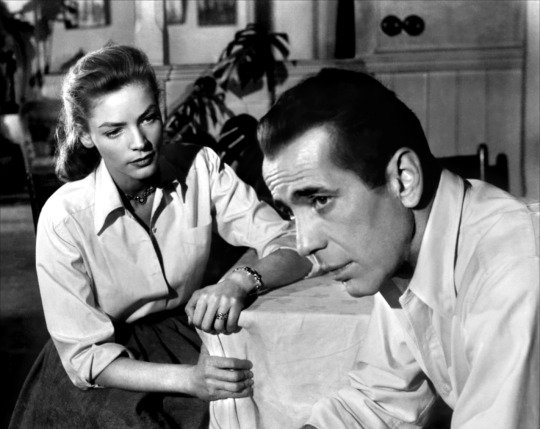
Key Largo (1948) - Not on AFI Top 100 but nominated for AFI Top 10 Gangster Films
The last film that featured the couple. In this movie, their characters were stuck in a Florida hotel during a hurricane. It was another John Huston directed film noir and featured Bogart's character boating around and taking out gangsters one by one. There is a somewhat racist subplot of hunting down some wanted Native Americans that a known gangster pins a murder on. That aspect of the movie always bothered me. A real standout that somewhat upstages Bogart (interestingly enough with his help) is actually the gangster's girlfriend who sings a song for the group to earn a drink. She plays a great part as a woman attracted by the villainous lifestyle and then becomes trapped in an abusive relationship. Actress Claire Trevor, who Bogart liked very much and encouraged throughout the film, won Best Supporting Actress for her part in the story.

The African Queen (1951) - AFI #65
Maybe the film with the most star power during the Old Hollywood Era, this film starts Katharine Hepburn and Humphrey Bogart, perhaps the two biggest stars of American film. It was his first film in Technicolor and the role won him his one and only Oscar for Best Actor. The film was shot in the Belgian Congo and once again proved Bogart's toughness. This was again a John Huston directed film and it is interesting that both of the stars of the film had friends in very high places that kept them acting in great roles: Humphrey Bogart had John Huston and Katharine Hepburn had Howard Hughes. I want to note that, in my humble opinion, this was neither actors best work but they both were given a lot of credit for braving the elements and appearing on screen looking haggard.

The Cain Mutiny (1954) - Nominated for AFI Top 100 but not ranked
This was the last film that Bogart was relatively happy with, although he had to drop his salary to get the part and he was bitter about it. The part of a paranoid captain earned the actor his final Oscar nomination, but it did not really bring the same satisfaction as earlier roles. Huston wrote Bogey's characters as a loner and an antihero with an internal warmth and humor. This character did not have the charm that exuded from Bogart, the person.
----------------------------------------------------------------------------
Humphrey Bogart continued with high profile roles like starring with Aubrey Hepburn in Sabrina (1954) and Ava Gardner in The Barefoot Contessa (1954), but he was starting to get sick from a life of smoking and drinking. He was also in his mid 50s and couldn't play that charming young loner that he was so famous for. He had started to come across as old and didn't have his youthful charisma. He really hated working with Billy Wilder and didn't want to be the distinguished older gentleman in Sabrina. He didn't want to work with Ava Gardner because she had just broken up with his drinking buddy, Frank Sinatra. These films were successful and Bogart was a true professional, but I would not call it his best work by any means.
Humphrey Bogart was a great actor and a true Hollywood icon. Through research and watching interviews, I don't think that he would have been somebody that I liked personally because he drank and smoked heavily while enjoying arguments and confrontation. He came off as a bit of a contrarian in his later interviews and that is something that has bothered me. Don't meet your heroes. It does not lessen his accomplishments as an actor nor does it reduce the number of great films he has starred in. Just because he wouldn't be my best friend doesn't mean he wasn't a great man. I still believe that he deserves the AFI honor of being Hollywood's most famous actor. Check out some of his works and see what you think.
#humphrey bogart#bogey#john huston#lauren bacall#key largo#casablanca#the caine mutiny#sabrina#katharine hepburn#the maltese falcon#the treasure of the sierra madre#introvert#introverts
44 notes
·
View notes
Text
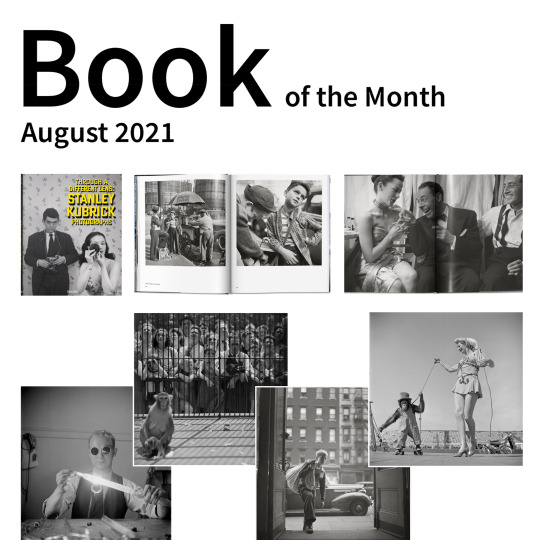
Book of the month / 2021 / 08 August
I love books. Even though I hardly read any. Because my library is more like a collection of tomes, coffee-table books, limited editions... in short: books in which not "only" the content counts, but also the editorial performance, the presentation, the curating of the topic - the book as a total work of art itself.
Through a different Lens
Stanley Kubrick (& Sean Corcoran, Donald Albrecht, Luc Sante)
Photography / 1997 / Taschen Publishing House
Every now and then, I sentence the kids to watch movies that I think are relevant - whether from a personal or a cinematic point of view. While my little son tends to be served light fare like "Blues Brothers," my big daughter sometimes has to chew a little harder, as happened the other day with "2001: A Space Odyssey." Her enthusiasm was a bit restrained, even if I exclaimed about 23 times, "That movie is from 1968. There were no special effects then, it's all actually built!".
Even regardless of that aspect, this epic can be considered groundbreaking. From the genre reference of the classical music background and the excellent script, to the technological authenticity and the almost psychedelic color scheme, to the revolutionary camera work. Above all, the visual composition of this film is the true mastery of director Stanley Kubrick, who is not considered one of the most important filmmakers of all time for nothing. Of course, I also have the matching book in my library ("The Making of Stanley Kubrick's '2001: A Space Odyssey'", also from Taschen, of course), but this time it's about another work of this visually powerful creator: his early work, photography.
"In the Streets of New York" is the title of the publisher's documentary "Through a different Lens" on the occasion of an exhibition of the same name at the Museum of the City of New York. For it was there that Kubrick, just 17 years old, went on his first stalk of optical impressions. In 1945, he signed on as a photographer for the magazine "Look," for which he photographed stories with a human touch in the streets, clubs and sports arenas of New York City for five years. In the process, he captured with his camera just about everything that made up life in the Big Apple in that era: People in the laundromat, the hustle and bustle at Columbia University, sports stars, showgirls in their dressing rooms, performers in the circus, Broadway actresses rehearsing their lines, cab drivers changing a tire, couples kissing on the train platform, shoe shine boys, boxers reconsidering their career choice in the ring corner, patients in their dentist's waiting room, prominent businessmen, politicians, children in the amusement park, and commuters on the Subway.
Even these photographs from Kubrick's younger years reveal a startling sense of composition, tension, and atmosphere, and seem like film stills to never-shot dramas from the jungles of the big city. "This exhibition reveals how (Kubricks) formative years laid the groundwork for his compelling storytelling and dark visual style. They also show a noir side of New York that's no longer around." (Vanity Fair) "Photography, and particularly his years with Look magazine, laid the technical and aesthetic foundations for a way of seeing the world and honed his ability to get it down on film. There, he mastered the skill of framing, composition and lighting to create compelling images," explains Sean Corcoran, curator of the exhibition "Through a different Lens" and co-author of the book. Apparently, it was clear to the young man from the very beginning where his talent lay and how he was able to hone and master it.
Stanley Kubrick was born in New York City on July 26, 1928, as the first of two children. His parents came from Jewish families, and all of his grandparents had immigrated from Austro-Hungarian Galicia. His early passions were excessive reading, cinema and chess. He was first gifted a camera, a Graflex, from his father when he was 13 years old. And he immediately took off as a photographer for the William Howard Taft High School student newspaper. After graduation, he turned his hobby into a career and at the age of 18 became a full-time photographer for Look, to which he had previously sold amateur photos. As early as 1950, Kubrick directed his first documentary, "Day of the Fight", about life in and around the boxing ring, which he had already explored photographically. Although only 16 minutes long, the film was already considered a sensational study at the time. His future career path was set, the rest is history.
"Through a Different Lens" was an extremely successful exhibition, which subsequently also went on tour. Not only Kubrick fans were impressed by the mastery of optical staging that was already visible at an early stage. Corcoran: "Kubrick learned through the camera's lens to be an acute observer of human interactions and to tell stories through images in dynamic narrative sequences. (His) ability to see and translate an individual's complex psychological life into visual form was apparent in his many personality profiles for the publication. His experiences at the magazine (Look) also offered him opportunities to explore a range of artistic expressions. Overall, Kubrick's still photography demonstrates his versatility as an image maker. Look's editors often promoted the straightforward approach of contemporary photojournalism at which Kubrick excelled. It's clear he always got the photographs that were needed for the assignment, but that he was also unafraid to make pictures that excited his own aesthetic sensibility."
Beyond the 100 photographs in the exhibition, the book presents 300 of Kubrick's images, including unpublished shots and outtakes. Annotated by Corcoran, his colleague Donald Albrecht, and renowned writer and critic Luc Sante, who has published most notably in Interview and Harper's. They place the motifs in their context, refer to stylistic aspects, and thus point to Kubrick's (imminent) artistic career. Above all, in contrast to the exhibition, the book offers all friends of photography - whether fans of Kubrick or not - a rare insight into the proverbial pioneering early work of a brilliant artist. And into one of the most interesting eras of the "city that never sleeps" - yes, even Frank Sinatra was photographed by young Kubrick.
From the extensive, mostly euphoric reviews of the book "Through a different Lens" or the oeuvre documented in it, let's take one example each from a professional and an amateur:
"The man who later led a genre to its lonely high point and at the same time to its final point with each of his films knew already at the age of barely 17, that's how old he was at the time, that expression and form shape every impression." (Die Welt)
"I can't praise this book enough. Wonderful collection and very informative. An absolute must for those wishing to understand more of how Kubrick valued the frame." (Yvi on amazon.com)
P.S.: Just for the sake of completeness, let's mention Kubrick's cinematic output after his breakthrough: 1960: Spartacus / 1962: Lolita / 1964: Dr. Strangelove or: How I Learned to Stop Worrying and Love the Bomb / 1968: 2001: A Space Odyssey / 1971: A Clockwork Orange / 1975: Barry Lyndon / 1980: The Shining / 1987: Full Metal Jacket / 1999: Eyes Wide Shut. No, this is not a selection of greatest hits, this is a complete listing. And thus the proof that he has indeed realized a significant peak in the respective genre. His great influence on the history of cinema is also shown by the fact that he is the only director to appear a total of five times in the list of the 100 films with the best critics' ratings.
In addition, two side notes: Kubrick spent several years preparing a film biopic about Napoleon Bonaparte. The preparations were so far along that he could have started production at any time. However, the release of "Waterloo" (1970) and its poor financial results dissuaded him and the film studio from the project. The project has since been known as "The greatest Movie never made". He also dealt intensively with the subject of the Holocaust. After the release of "Schindler's List" (1993), however, he discarded these plans explaining that Steven Spielberg had already told all the essential.
Stanley Kubrick died of a heart attack on March 7, 1999, in his home at Childwickbury Manor near London, where he had lived in seclusion since the 1960s and had set up studio and editing rooms in the former stables.
Here's a short trailer for the exhibition "Trough a different Lens":
https://youtu.be/EgPlnjeBs7E
youtube
#stanley kubrick#look magazine#taschen#new york city#photography#book review#book#steven spielberg#Through a different lens#Sean Corcoran#Donald Albrecht#luc sante#2001: a space odyssey#museum of the city of new york#big apple#the city that never sleeps#cinema#movies#director#visual style#visual storytelling#Youtube
3 notes
·
View notes
Text
Lucifer 5x04 - The Mega Meta

This episode, the one all the cast and writers praised turned out to be the most challenging for the audience. Several hated it mainly for interrupting the flow of S5P1 whilst introducing a ‘weak’ story for Lucifer’s ring. Others loved it for all the meta, the concealed trivia and details that exist in that episode.
In my opinion 5x04 took it’s time to warm up to my heart and therefore today it’s time to write a meta on it. I’ll try to cover all the bases and if I miss something I apologise!
This meta will analyse, lines, settings, songs hopefully with the order they appear in the episode, as well as hints that it gives us for P2, the end of the series and many more things.
The credits open to Lucifer whistling as per Netflix’s subtitles ‘Chattanooga Choo Choo’
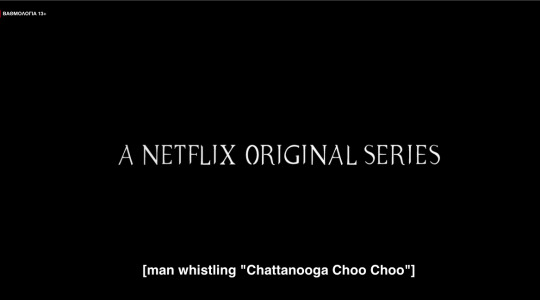
A song of about a man waiting for his train as he gets a shoe shine. The lyrics reveal at the end that a girl is waiting him at his destination and that he intents to marry her and settle... A good foreshadowing about Lucifer no? Especially after the S3 game night fiasco...
There's gonna be a certain party at the station Satin and lace, I used to call funny face She's gonna cry until I tell her that I'll never roam
By the way what’s this obsession over daggers and them killing people? Didn’t we have enough with the Flaming Sword in S2?

Trixie: Has it ever killed anyone?

Let’s keep it that way kid... Although I doubt it.
Now take a moment to realise that Lucifer was in Hell for thousands of years. He hasn’t had sex since his relationship with Eve and for his last night on Earth he prefers to play a game of Monopoly with Trixie and only when she turns him down Lucifer suggests getting a drink at LUX always in her company. That’s progress...
It also busts all claims of Lucifer being a sex obsessed maniac.
The year is 1946...
WW2 is over and we find Lucifer in a new setting, a familiar one where through the episode we see that he has not just visited again but he is frequent visitor around that time. Just a few years later after all he was seen through Kinley’s photos in Nazi Germany. Now we know it was because apparently he owns a castle there, in the Austrian Alps... Not exactly in mint condition after the war though...
By the way the castle that corresponds to that 22 bedroom description Lucifer gives is Schloss Ernegg Castle which belongs to the same family since the 17th century and it’s in great condition. Actually it operates as a hotel!
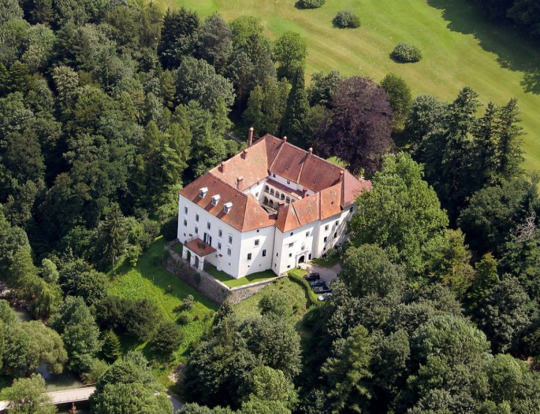
The Hurry plays as we see Ellis strolling the WB New York area of the lot. Great old ones were shot there.. Like The Big Sleep (1946) staring Bogart and Bacall which was shot in 1944, reshot some parts in 1945 but was released after all the ‘proper’ war time movies were released first.
A bit like this episode The Big Sleep carries ‘process of a criminal investigation, not its results’. Also around that time we have The Killers coming out, The Killers is important to mention as aside from being based on a story by Hemingway who was in Cuba in 1946 not in New York as Lucifer claims, it was directed by Robert :. Siodmak made most of the Hollywood’s noir classics and was always faithful to the doomed attraction which would always resolve to a nihilistic conclusion... (Thank you wiki! :P)
The connection to Lucifer, between the lines and the off hand comments like Hemingway is that noir films were based on the German Expressionism in cinema, and one of the most prominent figure for the US was that one German director Robert Siodmak.
The purpose of the above information is in order to tell you that a black & whte effect and a crime story is not what makes a noir episode. The writers were faithful to the core of noir. Entrapment, flashbacks, narration. The tropes of murder, jealousy, backstabbing and crime is also there, easy to replicate after all for sure. A dead man walking and ‘selective’ amnesia is also convenient...
Triumph and tragedy can be found and lost in the maze of the cities and in questionable establishments... Like in bars...
Moving on!
The credits open and we listen to The Hurry Up played by The Heath And His Orchestra. Dear Heath was British not an American. A subtle nod to Ellis probably as the leading man. But here is the thing Heath was the performer not the composer of that piece. The composer was Kenny Graham (Again British) and probably that piece was written after 1958 but anyways it’s an inconsistency we (-I-) can certainly live with!
Lucifer and Lilith last meeting was at around 1770 (Marie Antoinette was born in 1755) now whether in Austria or France who knows.... I would assume that Lucifer stayed in Austria until WW2 as aside from the wars and other issues it had a great cultural field for him to explore such as literature, music and lacked the brashness of the new-founded then US (1776).
Tiny issue here... Moctezuma (The 2nd) who Lilith claims to have met died in 1520, a bit after Cortés arrived in what we know today as Mexico so we can assume that Lilith travelled between the New World and Europe until Lucifer found her in New York in 1946.
Lilith in a relationship with Tommy Stomponato who owned the club, she probably influenced him enough to name it ‘The Garden’ as se admits to Gertie later in the episode, she really loved that Garden hence why she took a small part of it with her.
Now the name Tommy Stomponato is directly influenced by Johnny Stomponato part and bodyguard of the Cohen Mafia boss Mickey Cohen. Now funny thing he was stabbed by Lana Turner’s (Hollywood star) daughter Cheryl Crane... That remind us a bit of Gertie as she yes both were stabbed by a woman but both were not prosecuted. The first as Lilith didn’t want Gertie to lose the limited time she had with her husband and Cheryl because she claimed self-defense.
The first time we see Lesley Ann as Lilith she sings ‘I want to be evil’ originally performed at the debut of Eartha Kitt and first released in 1953. It is considered brilliant for it’s feminism and ‘video clip’ starring Kitt...
youtube
It’s a song that carries Lilith’s agony which even Eve carried. The need for freedom, the need to break the chains of what they should be and what we see that even Maze carries throughout the series. It’s a song that reaffirms that betrayal towards God, Adam and Lucifer in Maze’s case is not an act of evilness but the need of these women to re-sculpture themselves without aid or instructions. In Kitt’s case it was social conformity. Also Johnnie Ray was the ‘guy who cries’ aside from his hit song in 1951 ‘Cry’ him crying after his wedding was received with mixed feelings I believe from the press and his fans.
Now we see that crime for Lucifer was fun and again he wanted to Laugh with Hemingway who again in 1946 was not in New York but had just starting to write his novel ‘Garden of Eden (published posthumously in 1986) and it explored the reversal of gender roles a bit like this Lucifer episode does.
So Lucifer accepts the case of finding the ring but needs help. Jack Monroe is the one that can help him and the name is inspired probably by Iowa’s born Jack Monroe Marvel character who lived in New York, fought the Nazi (See Jack talking about the Battle of the Bulge), sidekick to Captain America - in a way - and ended up shot and killed. The character had many cliche detective phrases. But that’s mostly a likely speculation :P
Now as Jack goes to talk to the ‘rat’ Lucifer comments on Gertie serving him a drink ‘Just what the doctor ordered’ an obvious connection to Harris playing Dr Linda.
A nice prop is the machine gun over the bar an alleged gift from Al Capone who had been arrested 17 years earlier and died in 1947.

Thanks for listening, XOXO A. Capone
Now Lucky Larry who ends up dead is wearing an eyepatch probably a nod to another great director of noir films and of german expressionism in cinematography Fritz Lang.
At that point we have the talk between Lucifer and Jack concerning the laters problem with his wife. The story as everyone has noticed is a parallel with the issue that Lucifer and Chloe never begun on an equal ground. Someone had manipulated them and in both cases both parties suffered. Both men were manipulated by someone over them in hierarchy and both stood on a dilemma on how to proceed. It took Lucifer over 60 years to realise how difficult it was to leave and even then in 2x14 he returned.
As Jack and Lucifer get to Willy’s mansion all the paintings depict him as a great warrior in all possible eras. As Napoleon, Fritz of Austro-Hungarian Empire, Henry the 8th, Ivan, and that armour I believe it was from Carlomagne?
Also Hannibal crossing the Alps?
The little sausages are self-explenatory for the character and perhaps the lilies in his house a connection to the episode and the P1′s plot.
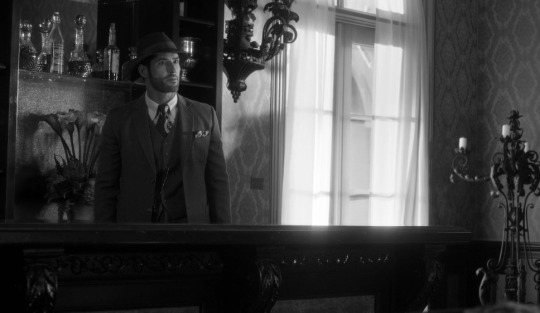
Lucifer checking the armour’s genital protector? Priceless :P As was Willy’s connection to Dan.
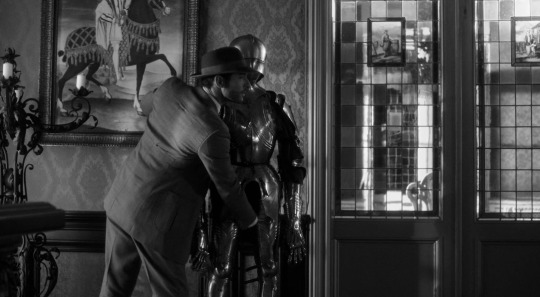
Now something that always make me wonder is why Lilith calls God Adam’s father as if she never considered him her own. At the same time she gives us a big hint there. She never walked away she was ‘sent’ away.
Gertie reveals there that her husband was wounded at the Guadalcanal campaign which ended in 1943 meaning that Bill was unresponsive for about three years at that point. The good news is that Bill seems to have been inspired by Bill Lentsch. Lentsch wrote a memoir called My Story and then adapted under the Title Hope For Wounded Warriors.
As a wounded warrior, Bill Lentsch knows the frustrating feelings of apparent helplessness and hopelessness. A sea-going Marine on the cruiser USS Vincennes at the beginning of World War II, he was a "hot shell catcher". The story of Bill's survival when the Vincennes sank is a story of miracles. In contrast, the story of his post-war rehabilitation and readjustment to civilian life, including a bad marriage {Sanoiro: At this point we have a differentiation but you never know}, contains more than its share of dark pages and the consequences of poor choices. Contemplating the option of murder, then suicide, was a vivid reality. Thankfully, the story of his later years brings hope and inspiration as Bill shares his personal journey of discovery.
Meanwhile the investigation continues. In the apartment we see pigeon cages a rather popular hobby back then in New York and not just for the messages they transported. Also do notice the WB water tower in the back. Iconic!

Lucifer finds a cuban cigar. Romeo y Juliet. The meta here obvious bit nonetheless important to our main love story.

With Stomponato dead we have a chance to delve a bit to Egyptian mythology.
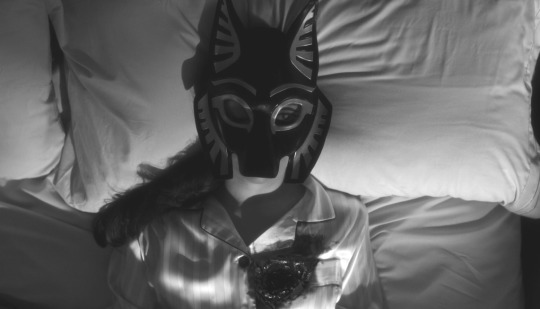
First the missing heart. The main organ that according to ancient Egyptians held the answer of how well you had done while you lived and what you deserved after death. It was measured and a conclusion sent you to afterlife or to damnation.
Second the Anubis mask. He was the God of Death who oversaw the heart weighting process. The colour black symbolised the Nile’s sand and thus regeneration as the river was a symbol of life. Anubis was adopted by Isis
Third the Eye of Horus. The Eye of Horus was used as a sign of prosperity and protection, derived from the myth of Isis and Osiris. This symbol has an astonishing connection between neuroanatomical structure and function.
That’s the basics but you can go further from there if you want to just remember that Egyptian deities hold an Ankh the symbol and work of life.
In 504 we learn that death is final, there is no eternal life. It cannot be given as a commodity, the ring cannot help so I would focus more on the stone itself and if Lilith’s immortality is used then it will not be used as it is in my opinion but more about that later on.
The shop sacred eye and the high priest take us back to two episodes of S1. First in 1x07 - Wingman where the high priest parallels the auctioner who was ready to sell everything of ‘supernatural’ worth knowing they were mostly garbage to make money. Second 1x12 - #TeamLucifer the satanic high priest who had said ‘-the Devil ain't gonna buy me an Aston Martin’. In 504 the High Priest wanted a Pontiac.
Lucifer comment on Tutankhamun loving the pre-sacrificed bloody heart might have to do with the Egyptian mythology that If a heart during the scaling was judged to be not pure, Ammit (female demon/god) would devour it, and the person undergoing judgment would not allowed to continue their afterlife journey.
One of the best lines delivered in this episode is also foreshadowing P2 in my opinion and why not some bts but not clear or definite ones.
In the modern age, we are taught to fear death. But the ancients understood that death... is power. - High Priest (Lucifer 5x04)
It is why I always say that death is not the last frontier in our series and as such it should be taken neither as the final chapter to an individual’s story nor as irreversible (with the right collaterals always) somehow. Although you cannot cheat death forever, this is the beauty of our story. Death is valued just as much as life.
As such as we are in the High Priest ‘office’ it is not accidental we see the Tree of Life (See my Tree of Life Meta *Here*). The designs are Celtic around the mirroring tree of Life in what we can assume is in Life and Death is as vibrant and ‘alive’ in both sides.

1) triskelion: meaning the three legs, is an ancient pre-celtic symbol that can be traced to the bronze era. It symbolises the holy trinity in Christianism but also the inner and outer world of spirits. As you can tell it holds a variety of meanings and even if it is just there, picked in random from the WB prop house we should note that it also symbolises the trinity of life, death and rebirth as well as the trinity of the transition of womanhood. The Triple Goddess: maiden, mother and the (older?) wise woman.
For this meta we will take the trinity of life, death and rebirth as well as elevate it to the transition of our lead characters. Chloe as a young woman, a mother and now a ‘wise’ older and more mature woman. Lucifer as the young rebel, a struggling with maturity and responsibility man and what he may become by the end of S5 without shedding any of his prior roles and identities. Only this time his identities no longer ‘stain’ him.
2) Knotted symbol - Eternal knot: We see them in many cultures and religions in Buddhism they represent birth, death and rebirth. In the inside we see Solmon’s Knot a symbol of immortality and eternity but some also parallel it to Lover’s Knot (See True Lover’s Knot), an ancient symbol of commitment and love. From this keep the eternal part of the symbolism which is often depicted in jewish cemeteries.
3) Celtic Cross: They are said to be based on some cases to the Egyptian Ankh (See Coptic Crosses), some also allege the design in the combination of the Christian cross and the pagan sun disk.
4) The Celtic Tree of Life: For this I take what is written in this site
The tree represents rebirth. Trees were said to guard the land and acted as a doorway into the spirit world.
The Tree of Life connects the lower and upper worlds as its roots grow far down while its branches reach high. The tree trunk connects both of these worlds to the Earth’s plane. It was with this connection of worlds, that it was said that people are able communicate with the gods in the heavens using the Tree of Life.
Tree of Life knots symbolize the branches and roots of a tree which are woven together with no end to show how the cycle of life is continuous.
Through the second part of the episode I was always looking at Lucifer’s tie. I might be wrong but it reminded me a lot of gears, with a heart and clocks on it. Essentially the clock is ticking... in more ways that one as well as for Lilith but give me some more lines before I return to this meta point.
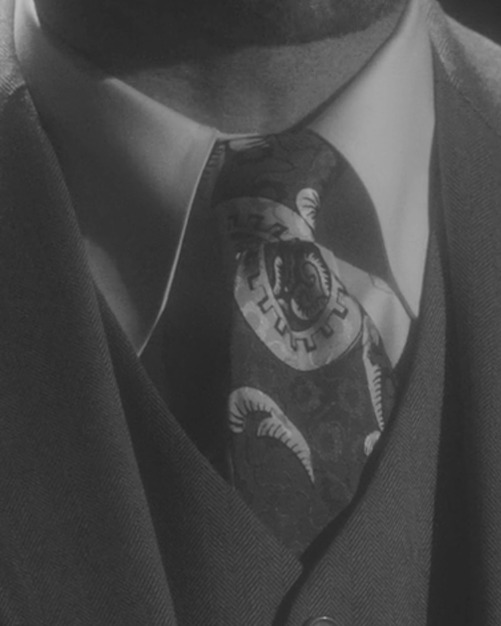
As Lucifer asks how humans believe her ring makes her immortal she ends her story with the line:
“I survive, and... somebody writes it on a stone tablet. You know how these things start.”
For me that was always a direct reference to the Favourite Son deal we had with the book in episode 2x17. As Lucifer said in 2x18 when Chloe asked whether his Dad said that Amenadiel was His favourite, Lucifer replies:
In so many Sumerian words.
Later on in S3 (3x14) Lucifer tells to Cain that Amenadiel is the favourite when he asks him as:
But the quick version: a book said it, so it must be true.
To be honest this re-occurring mentioning makes me hold to my belief that something was translated wrong there...
As the 5x04 sceheme to get the ring back is underway Lilith looks at Jack & Shirley’s interaction which is interesting not because it’s when Lilith starts to perhaps thinking of retiring her immortality but because a very special question comes to mind.
Michael knew the ring’s story. He claimed that he was the one who manipulated Lucifer into having his vacation, but his vacation just ‘happened’ to be at the same time Chloe was on Earth?
Here is a speculative meta.
Lilith asks Lucifer if he ever connected with anyone emotionally to which he replies:
Absolutely not. It would take a literal miracle for me to want something like that, and I'm fairly certain my father's not handing those out anymore.
It makes you wonder whether Michael was around listening, planning carefully his next moves. That that’s how he knew the ring’s story, or how he may have plotted Chloe’s miraculous birth by manipulating God.
At this point everything is possible but we should never forget that God at that point is still powerful and omniscience so Michael might be only alf of the explanation why Chloe is on Earth as a key for Michael to take down his brother and materialise his other plans. The other half is only known by God but will he be willing to share in P2 or even in S6 if he appears there?
Lesley-Ann as Lilith starts to sing ‘Someone to Watch Over Me’ a song written over the songwritter’s (Ira Gershwin) wedding anniversary, a true love song on many levels written in 1926 and featured in the Brodway Musical ‘Hey, Kay!’.
The musical’s plot is about an engaged womaniser falls in love with Kay and the song after lots of thought was placed to reveal to the audience of Kay’s realising that she is in love with the male lead, womaniser Jimmy.
We will never perhaps know if by imminence to Lilith’s first song lyrics, Lilith to a point was in love with Lucifer and held on to hope until she surrendered everything for a normal life not wanting to wait for the impossible. Of course that’s just one interpretation not a hard conviction of mine.
An analysis of the song writes:
When first composing this piece, the Gershwin brothers tried to capture the feeling of safety (and love) that everybody longs to have. The addition of the doll (a doll was added as the listener of the song in the rehearsals and stayed in the show) only enhanced the childlike, vulnerable side of the song that was being hinted at in lyrics such as, “I’m a little lamb who’s lost in the woods.”
Although many artists sing this like a love song, its first performance, directed at a doll, gave the piece an aura of safety not usually present in romantic songs.
Perhaps that safety should be also attributed here. Lilith still has her safety still holding on to her immortality knowing though that she will surrender it. Lucifer is unaware he one day will surrender his willingly because he fell in love.
In the end they both carry the vulnerability of needing someone to understand and love them. No matter how cynical we find both Lilith and Lucifer with his brutal Caligula orgy comments, they both crave about someone. Both have lost hope to their Shepard aka God/Dad.
Perhaps I’m wrong on my first impression with Lilith and her affection towards Lucifer. Perhaps they both are the prodigal children, lost in the woods wishing for someone to finally take care of them but no longer hoping for one, until Lilith takes the leap. Lucifer will need almost 80 more years and Chloe Decker to let someone take care of him.
Perhaps that’s why they do a duet on the lyrics:
Someone who'll watch over me
I'm a little lamb who's lost in the wood I know I could, always be good To one who'll watch over me
And the case is back to move the episode forward and enter the present Lucifer Trixie interlude and ‘Forget it Trix. It’s Chinatown!’
That line was the most obvious one as it comes from the more recent noir movie with Bogart and Chinatown (1974). In the movie aside from the mystery plot Evelyn - the mother eventually dies, the twist is that of an abuse which led to her daughter/sister’s birth and although that does not fit our serie’s plot the death of the main lady might. All a speculation so do not be dishearten remember all the above and this is not an S&S it’s a meta :P
After all Lucifer’s line goes back to the complex dealings in Chinatown and how understanding something fully is not always feasible.
Interesting is also how Lucifer shots, albeit the foot not the leg, of willy to prove Willy is not immortal. Like Chloe did to him in 1x04 and to Michael in 5x02. Jewelry is not going to save anyone. Big words but you know me. I believe in other provisions or actions even if they include the ring.
We all die, Lily. And that's okay. Truth is... I'd rather die today trying to save the man I love... than live forever without him.
The past, the present and perhaps the future?
The case is resolved and Jack follows Shirley to Des Moines (Capital of Iowa). That’s an inner joke as Joe Henderson is from Iowa and graduated from the University of Iowa.
Before Jack follows her remember that Shirley had asked more from him when he told her to be careful. A bit like Chloe in the evidence room in 5x08. If some have watched unconditional love then you might remember the scene where Kathy Bates tells to her husband played by Dan Aykroyd that him telling her ‘I love you was never a condition but at that point it now was. Similar to what we saw Chloe asking from Lucifer. A foreshadowing perhaps that eventually Lucifer will follow Chloe.
Now two things. Lucifer in episode 504 prepares their game night. He is now comfortable and even enjoying their game nights, he find himself right where he wants to be without being fearful of being dull. He is a shoe and that’s fine.
When Trixie asks Lucifer whether Jack and Shirley had a happy ending he tells her probably not as they moved to Des Moines meaning it was a boring move between New York and Iowa in general. Iowa and Des Moines have been used several times in jokes by the way due to Henderson.
Now back to Lucifer, at that point he does not see that sometimes sacrifices that lead to ‘boring’ lives are the best outcome and happiness is not equal to excitement but he is a slowly maturing Devil...
That part can help us to analyse the end of the story from 1946.
Lucifer says: Once you do this, there's no going back.
This implies that whether you surrender your immortality or gain it -for the second I’m quite doubtful it can be done on the same terms - it is forever. No going back.
Lilith’s next words reveal a broken woman who gets her Hail Mary and hopes for the best. As a parent she offered her children the best place to never realise they are lacking but Lucifer by bringing Maze to earth undid that as Maze slowly reaches her potential, learning there is a different way. God’s words echo since 3x26.
So was Lucifer a kindergarten guardian for Lilith? In a way yes but Lucifer in 5x04 understood Lilith’s logic. In their distorted image of how you can break an individual, the Lilims seemed safe from Lucifer’s and Lilith’s fates. Cast out, punished, unloved, lonely and in an unspoken despair to connect but too afraid to try again until Lilith tried again. The end of 504 showed she didn’t succeed o find what she was looking for. We have no way of knowing if we will see her again in P2 but it’s probable.
Lilith kisses Lucifer goodbye, making me once again wonder if a part of her did had feelings for him and wishes him back to enjoy the rest of his life as if somehow she knew, although she couldn’t.
The story ends here and perhaps the clock starts ticking for Lucifer through Michael. Perhaps the planning started with Penelope and John that were meant to be born, get married but not have children and then Chloe came along. But that’s just a theory...
And before the screen fades to dark, Lilith walks away with Lucifer standing in the middle of the street and we listen to ‘This Is Ours’ by Peter Sivo’s Band (1946-1961).
This is Ours lyrics are the words of a man which mystify me. For me it is a song that gives us a couple together after a very long time that reconnects. It was a meant to be couple but the past had to happen. He had to get married, for both of them to live apart their own lives until one day they get back together and now they can be together. There is no sadness, there is relief, contentment.
Several say that How I Met Your Mother had an awful ending. If you have not watched it and want to please stop here but know that I believe that the ending was just right.
In How I Met Your Mother, the lead (father) marries the mother of his children but it is revealed that she eventually dies and some years later he starts telling them a story that lasts ten years as all aspects of it in his belief is about how he met their mother. His daughter interrupts him saying that no it’s about how he met the woman he wants to be together now. They all know that the Mother was loved and was the One but in this life there is more, there are second chances because life happens and it’s not a bad thing and the time in between is as joyful as the future despite of the tragedies in between.
So a part of me wonders if Deckerstar will go a bit through that to a point.
Forget the past, for this is ours...
The thing is that a bittersweet ending gives as a possibility and then we are left wondering past that.
Trixie: I bet Jack and Shirley talked the whole bus ride and fixed everything. Lucifer: Yes. Yes, perhaps they did.
After all they did move to Des Moines... After that we can only guess.
21 notes
·
View notes
Text
Gilda (1946): An uncoventional femme fatale
-Isn't it wonderful? Nobody has to apologize, because we were both stinkers, weren't we? Isn't it wonderful? -Wonderful.
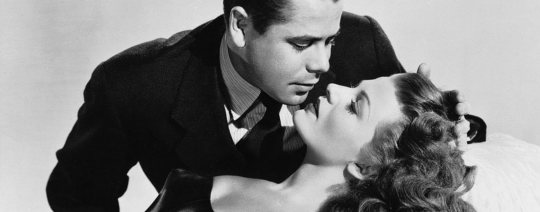
Gilda could be the ultimate example of a film in which a single scene transcends the entire film, making the viewer forget about everything. Some may not have even seen it yet, but they do know of that iconic striptease.
What is film noir without the relationship between the protagonists? What is left in a film noir when we strip it of this element, of those murky and sickly as well as fascinating relationships?
Make no mistake: the sophistication that characterizes film noir would be meaningless without the protagonists. And in this sense, Gilda has its own characteristics, something of a film noir, but with a development in its characters very different from the genre.
Here, the femme fatale doesn’t need a man to lead "to perdition." Her reason for being isn’t that, far from it. Therefore, Gilda breaks with that film noir rule; here the protagonists drag each other in that whirlpool that only brings misfortunes, which is resolved in a totally different way in this film.
One of the characteristics of film noir is that of the love triangle although, in this case, we could speak of two love triangles, one of them very particular. At the beginning of the film, we see Ballin rescue Farrell from the street, from the underworld of Buenos Aires.
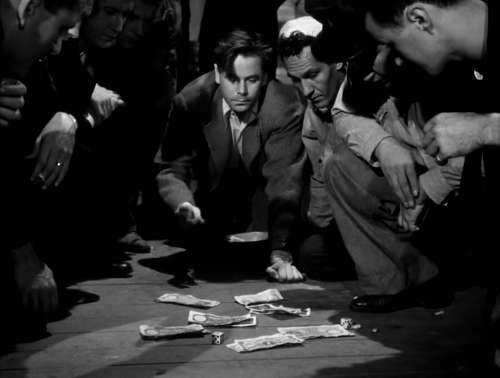
He has saved his life; one feels indebted and the other responsible for the act. Next we see the third component of this triangle, the cane. A cane that hides a a deadly weapon.
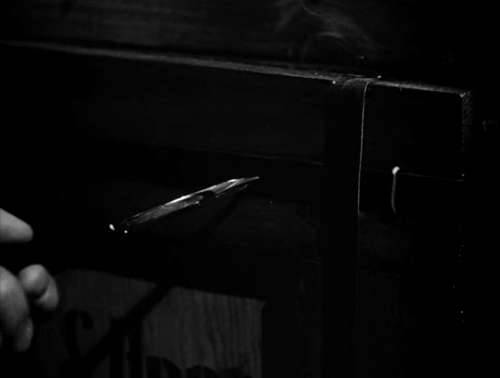
Ballin: It is a most faithful and obedient friend: it is silent when I want it to be silent, but talks when I want it to talk.
Farrell: Is that your idea of a friend?
Ballin: That is my idea of a friend.
It’s not trivial to consider that cane as another member of the relationship between the two men; in fact, when Ballin introduces Gilda, Farrell says: "I thought we were three already”, referring to the cane.
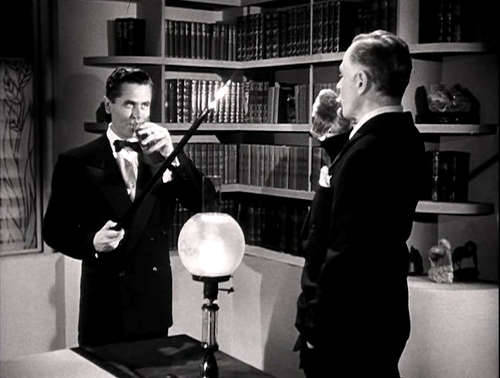
That strange triangle is agreed upon and closed with the following words by Ballin: “This I must be sure of, that there is no woman anywhere. Gambling and women do not mix.” Farrell becomes Ballin's right-hand, his best friend and confidant.
And there it is, the second triangle, and this time, the real one. Ballin appears with his new wife, Gilda, Farrell's old love. As they walk up the stairs, guided by Gilda's siren song, Farrell mumbles an "I hope everything is as before", which sounds more like a wish that he knows won’t be fullfiled; his relationship with Ballin isn’t going to be the same as before. He stands at the bedroom door while we see on his face that he recognises the voice, that voice that he has heard sing so many times in the past.
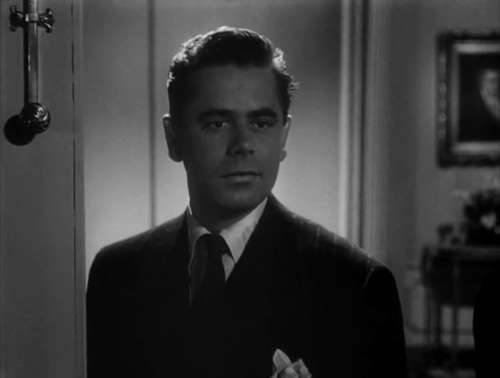
Ballin tells him that "he seems stunned" listening from the doorway. When Farrell reminds him of the "no women" pact, Ballin replies "my wife is not a woman.” And it is then when Ballin asks Gilda the question:
-Ballin: Are you decent? -Gilda: Sure I’m decent.
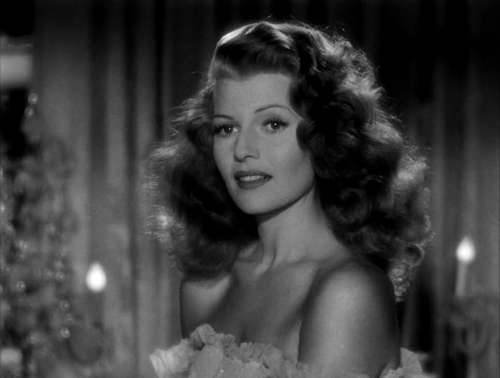
The tension between Gilda and Farrell is evident. We don't know what happened between them (that could be another movie), but the wound there is palpable; Ballin is no stranger to that, he realises it perfectly. The Casino workers notice too, in fact they joke about it. When Ballin asks Gilda not to call him "Mr. Farrell", but Johnny, she says "Johnny is a very difficult name to remember and very easy to forget."
And here that obsessive triangle unfolds, so obsessive that, despite Ballin's suspicions that Johnny and his wife knew each other from before, he asks him to stay near her, to take care of her. It seems to be a game that Ballin enjoy. That macabre game reaches its height during a dinner in which the three share a table, in which they toast the misfortune of the woman who made Johnny suffer:
Ballin Mundson : Now then, before we were interrupted, I believe we were about to drink a toast. So: disaster to the wench who did wrong by our Johnny. No, Gilda? You won't drink to that?
Gilda : Why not? Disaster to the wench!
When Farrell admits to Ballin that they knew each other from before, he says, "I taught her what she knows." Up to that point we can imagine what Johnny has meant in Gilda's life. Thinking that Ballin is dead, Gilda and Johnny get married in a wedding that could predict what comes next: we only see her through a window, through the rain that falls outside.
Johnny begins to punish her by leaving her alone, humiliating her, to such an extent that she has to go see him at the office: “Hello. Do you remember me? I am Gilda, your wife ”. Farrell enjoys humiliating her; He lights her cigarette by placing the lighter at waist height, so she has to "bow" to light the cigarette.
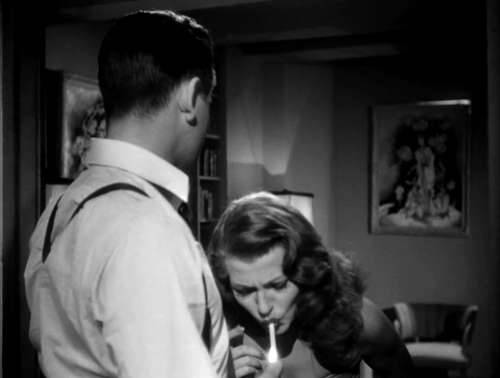
She married Ballin out of revenge on Johnny, and he marries her to humiliate her. So much so, that their new home is dominated by a huge portrait of Ballin. She is a prey to her past. She tries to run away from Johnny, but wherever she tries to go, he torments her.
When everything is over, Gilda surrenders and decides to leave the country; He returns to ask her to leave together, while apologizing for his behavior: “We were both scoundrels. Isn’t it wounderful". That obsessive triangle becomes a couple of neurotics, in which with their strange relationship of emotional dependence., they feed each other until they reach the point of recognising that it’s wonderful that they don’t have to ask for forgiveness or that anyone is guilty of anything, the two have been just as awful.
But Ballin returns from the shadows to claim what is his: his wife.
But prophetically it’s a member of the previous triangle, the knife hidden in the cane, that is going to solve this triangle, and this time forever. Ballin dies at the hand of his best friend,
The tagline for the film announced that "there is no woman like Gilda". There may not be a more iconic female character in film history. She has such strength on screen that perhaps because of that the viewer may not have been able to judge her in depth. She has nothing to do with the rebellious woman we all thought her to, nor is she a man-eater; Gilda is simply different. She is a woman with an apparent happiness, that hides an immense sadness and melancholia.
A woman who complains about "so many people and so much loneliness.” Her need for attention and love is palpable. From the moment she meets Johnny Farrell, The expression on her face changes: the past has returned. When Johnny first goes to the ballroom run by Ballin, he meets a beautiful woman and, when he asks about her they tell him: she is a harpy.
Harpies, fantastic beings with the face of a woman and the body of a bird of prey. In Greek mythology, they were the beings in charge to enforce the punishment of Zeus to Fineo, stealing his food. Later on, various traditions gave them malevolent connotations, carriers of catastrophes.
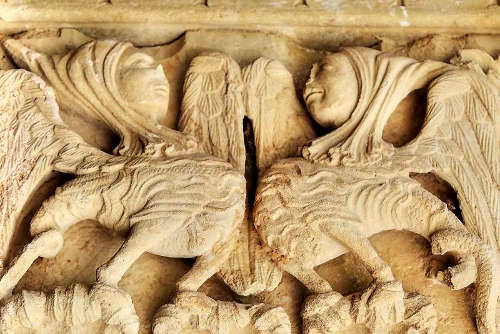
When Ballin appears to be dead, Farrell finds himself between two harpies reading Ballin's will and instructions.

Gilda can’t be considered the classic film noir femme fatale. She seeks to torment Johnny, but in order to make him jealous, her end goal is not money, as is often the case with the film noir woman; She is in love with him, she marries Ballin for money, yes, but it’s a question that Ballin was not oblivious to when he married her; for him she is a beautiful and hungry little girl.
He feels like a man, he realises himself as such by feeding her. But Gilda's wound is very deep; referring to Farrell, she says: "I was once loyal to a man, and look what happened." Ballin justifies her marriage to him: “She said she was born the day she met me. The three of us have no past, only future. Interesting, right?". Those same words are the ones Johnny used when he met Ballin, who had been born the day he met him.
There are two very important themes in Gilda: hatred, hatred that’s been shaped by Gilda’s pain. She reiterates many times how much she hates Johnny, but it’s a simple excuse; She loves him so much that she has had to turn the feeling into hate as a barrier against pain: “Hate can be a very intense emotion (…). Hate is the only thing that warms me. ”
And Farrell in turn thinks about her: “I hated her so much that I couldn't forget her. I was in the air I breathed.” The reunion with Johnny makes her want to plunge into a self-destructive spiral that, that would destroy everything she knows. Her words to Johnny are very significant: "I hate you so much that I would destroy myself to drag you down with me."
But the love game she plays with Johnny reveals something else: She doesn’t hesitate to be seen with other men to arouse his jealousy, a game into which she falls very easily. At the Carnival, with another identity, with a mask, they dance as it seems they did before. She’s mischievous: “I can help you regain practice. I mean dancing. "
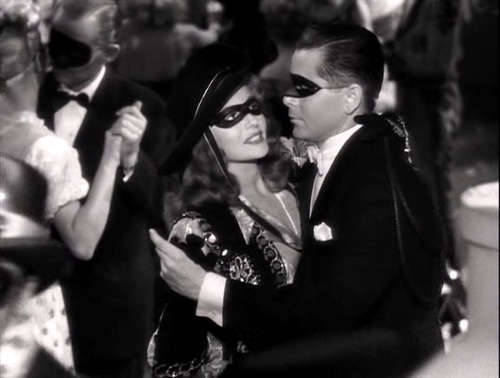
He asks her to throw her hat back. He shoves her away violently while she laughs amused. The love-hate game between them is very powerful. We can’t forget the famous slap that he gives her ... although he doesn’t escape a few himself. The game of erotic power play and violence often present in film noir is very noticeable here.

When he takes Gilda home, she does’t hesitate to stress again and again that they are alone. He can’t avoid the temptation and goes up to the bedroom. She has removed her disguise, she is Gilda again, a Gilda in the shadows. They hesitate whether to approach each other or not: "I hate you so much that I think I'm going to die from it ... darling." Their neurotic behaviour could be summed up in this phrase, in that kiss during which the two explode when they say that they hate each other to death.
Gilda’s death drive leads her to an obsessive superstition, another important theme in this film, in which she leaves her life and actions in the hands of that belief, she sees signs everywhere and subjects her life to that destiny. The night the three of them toast to the misfortune that Johnny suffered (herself), she is afraid to drink the glass, as if consuming the champagne closes a pact with the devil.
But after a moment of doubt, she drinks without hesitation, as if that liquid were a poison and she wanted to die right there. She doesn’t care that she’s toasting to her own misfortunes. She’s so superstitious that when she tells the maid, she asks her not to repeat it. Whilst being in luck at roulette someone says "lucky in the game, unlucky in love", and she stops playing to avoid tempting luck. On her wedding day with Johnny, a lonely, sad and glamorousness wedding, a wedding that we as spectators only see through a window, she says: “The rain has stopped. Maybe it means something. ”
Of course Gilda is not the typical film noir woman. She is a tremendously sad woman, sadness caused by love, and who seeks to flee from herself, from everything inside herself.
A woman afraid of her husband and destiny, fearful of life, in a word. In the end, feeling cornered by everyone, the only thing left for her to do is a farewell worthy of her, an iconic dance: She knows she’s being observed by everyone, especially by Johnny. A song in which she asks to blame someone else, "Put the blame on me."
Don't blame Gilda; she’s already fleeing Buenos Aires. But Johnny asks her to go with her. What was Gilda looking for? To be loved. Nothing more, nothing less. Gilda represents the “whore” who wants to emancipate herself to become a mother. Almost no woman in film noir is a mother, a femme fatale is not a mother, she’s a temporary distraction and obstacle to the hero.
But Gilda wants to escape such a condition, and we could really see her as a loving mother and living together with Johnny. In Gilda the woman could be seen as a symptom of the man, Gilda comes to substitute those other symptoms that these men have (sadistic in the case of Ballin, vengeful in the case of Farrell), and take them out on her.
Film noir always plays with appearances: nothing is what it seems to be. But in Gilda, this premise turns to "but in the end everything was what it seemed to be." That game of appearances, like at the Carnival, ends when the participants remove their mask, this time, in a violent way. Neither is Ballin the good Samaritan who saves lives altruistically, nor is his Casino his main activity, not even his death is true. We are shown his shadow on different occasions, in profile; we never see him fully.

Gilda and Johnny’s life is also a lie, to bear their pain. The Casino is itself a lie, a place that Ballin uses to hide his work, and that he has arranged to be able to see without being seen. His office is upstairs, from where, thanks to a set of lights, blinds and windows, he can see everything, like an omniscient God.

It’s the only way out of the suffocating atmosphere of the game room. Gilda is no stranger to what that game of points of view can provide to her, on two occasions she knows she’s being observed by Johnny, she seeks to be observed by him, but she doesn’t see him watching her, as if he doesn't want to see her face and guess what she’s thinking at the moment. The final moment, Gilda’s iconic dance, seems meticulously prepared for him to observe her, but also for him to see how others look at her. What does Farrell do? He stops her. He can’t stand what’s happening.
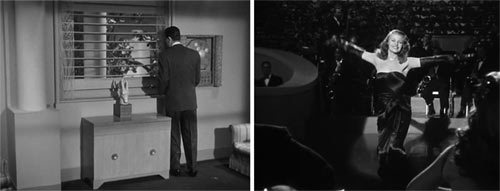
Doesn't that moment remind us of this one from Paris, Texas?
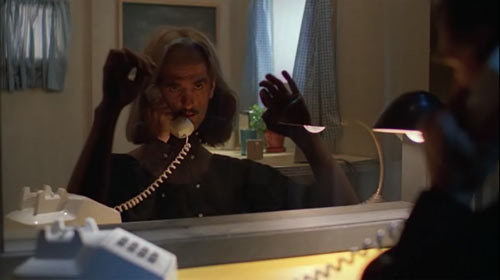
Or this one?
Two absolutely different women, but in a sense mirrors of each Gilda is the whore who wants to emancipate herself to become a mother; Jane is the mother who emancipates herself and becomes a whore, once Travis appears, she takes the path back to that role of mother. Could that moment that game of points of view, be the beginning of that emancipation, of that path?
That claustrophobic environment and that game of viewpoints is exemplified in Gilda and Johnny's wedding: We only see her through a window, through a rain curtain, we don't even hear what is being said inside the room. We are spectators. But aren’t we during the entire film?
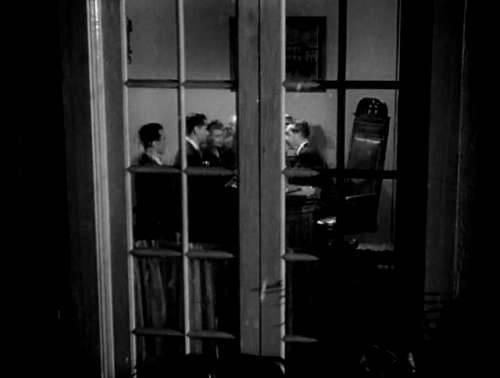
Gilda’s iconic phrase: If I'd been a ranch, they would have named me "The Bar Nothing.", is now more ironic than ever. No, she is not the free woman we were made to believe; she has an owner, Johnny. The mare is back with the stallion.
@purecinema @idasessions @missdubois @mad-prophet-of-the-airwaves
#fave#took me ages to write#gilda#gilda 1946#charles vidor#rita hayworth#glenn ford#film noir#40’s cinema#cinema#movies#films#film review#movie review#movie analysis#film analysis#filmista
55 notes
·
View notes
Photo

No Man of Her Own (1950)
Who likes 70-year-old movies? I do! I do!
This noir-ish tale stars Barbara Stanwyck as the unmarried baby-mama of a real schmuck (Lyle Bettger). Barbara knocks and pleads and cries but he won’t help her and leaves her to figure things out while he shacks up with his new dame.
Barbara gets on a train which crashes of course. While recovering, the hospital identifies her as the widow of a man who died in the train crash. She goes along with it because she wants a home for her baby. And the people are so nice. Including her ‘brother-in-law’ (John Lund) who falls in love with her.
Hilarious hijinks follow. JK. LOL.
It’s really a bit drawn out. Too much voice over. Kind of soap-opera-ish. And the disposal of a body in the most awkward manner. Plus Barbara as a mother looks clumsy. But I know women were supposed to do that in 1950. I guess that’s why the writers didn’t make her get a job as a model... cuz she was a mother. I mean, you can’t be both.

Still, the screenplay for No Man of Her Own was penned by two women with dozens of writing credits. Sally Benson and Catherine Turney. They could have tightened it up a bit, in my opinion. The original novel (I Married a Dead Man), was written by Cornell Woolrich who also wrote Rear Window and about a million other stories that were made into films.
When I think of Barbara Stanwyck I think of Double Indemnity or the funny one with Henry Fonda. The one where he falls a lot. Oh, and the Christmas one. Now that I think of it, she is in a few films where she plays duplicitous women. But IMDB says she’s best known for her television roles? I never even knew she watched television.
Stanwyck was nominated for 4 Oscars before 1950. She never won although her work is considered classic art now. And she worked steady from the 20′s to the 80′s. C’est la vie, Barbara. Say La V..
#no man of her own#barbara stanwyck#john lund#lyle bettger#sally benson#catherine turney#1950#1950 cinema#70-year-old-movies#cornell woolrich
4 notes
·
View notes
Text
Book Review: Stories from the Trenches by Marco Siedelmann
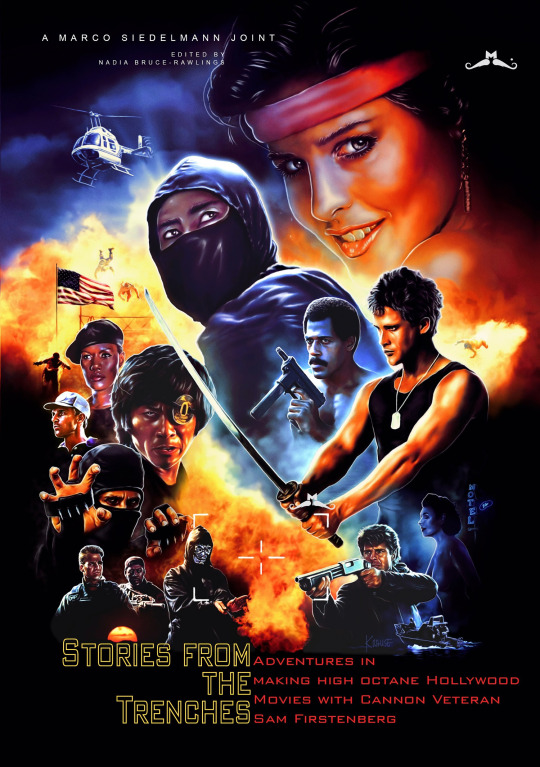
If Electric Boogaloo: The Wild, Untold Story of Cannon Films - Mark Hartley's excellent 2014 documentary on the independent film company - left you wanting more insight into Cannon Films' glory days, look no further than Stories from the Trenches: Adventures in Making High Octane Hollywood Movies with Cannon Veteran Sam Firstenberg. The book features firsthand accounts from filmmaker Sam Firstenberg and many of his collaborators. One of Cannon Films’ in-house directors during its 1980s heyday, Firstenberg helmed such cult classics as American Ninja, Breakin’ 2: Electric Boogaloo, Revenge of the Ninja, and Ninja III: The Domination.
The exhaustive read consists of a series of career-spanning conversations between the 70-year-old filmmaker and writer Marco Siedelmann over the course of 755 pages, along with anecdotal asides, interviews with his cast and crew (most of which are new, although some archival pieces are peppered in), and a plethora of black-and-white photos. Rather reworking the interviews into a narrative, the questions and answers are printed verbatim. It's segmented into seven chronological chapters, each of which is further broken down by film. The massive tome is coffee table book-sized but paperback.

The book kicks off with an introduction by Firstenberg, in which he explains how he came up with the title of Stories from the Trenches when he was considering writing his own memoir and what it means to him. He also sets the stage with a humorously stark contrast between his low-budget B-movies and their high-profile Hollywood brethren. It's followed by an introduction from film critic Oliver Nöding, who warmly explains why, as a teenager, he thought Cannon Films was the best studio in the world and Firstenberg was their standout director.
The first chapter, "The Early Years," explores Firstenberg's upbringing in Jerusalem, formative exposures to cinema, film school experience, working his way up the hierarchy as an assistant director (under Empire Films' Charles Band and Cannon Films' Menahem Golan, among others), and making his feature directorial debut on One More Chance in 1983. It also features interviews with assistant director Leo Zisman (Jane the Virgin), production manager Omri Maron (Iron Eagle), and producer David Womark (Life of Pi).
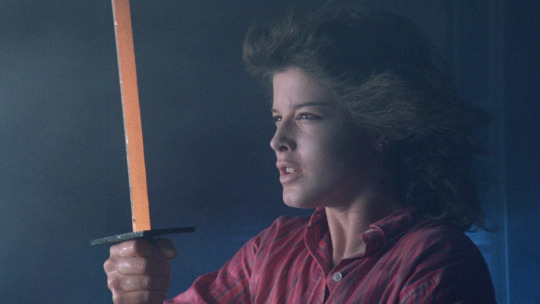
Stories from the Trenches really picks up, as does Firstenberg's career, in the second chapter, "King of the Sequels." The filmmaker opens up about his next three films - 1983's Revenge of the Ninja, 1984's Ninja III: The Domination, and 1984's Breakin’ 2: Electric Boogaloo - which happen to be among his most well-known works. He breaks down key scenes in each movie and discusses his relationship with Cannon Films.
This chapter is accompanied by interviews with stunt performer Steven Lambert (Titanic), editor Ken Bornstein (America's Next Top Model), karate champion Keith Vitali (Wheels on Meals), actor Jordan Bennett (Ninja III), producer Alan Amiel (The Blackout), cinematographer Hanania Baer (Masters of the Universe), and Breakin' cast members Lucinda Dickey, Michael Chambers, and Adolfo "Shabba-Doo" Quinones.
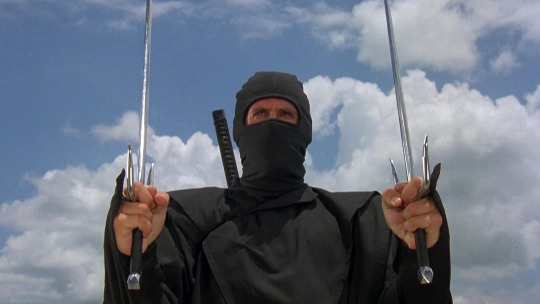
"The Golden Age of Cannon," is another interesting chapter. Set against the backdrop of the rising home video market, Firstenberg finds his voice as an action director on 1985's American Ninja before going on to make 1986's Avenging Force, 1987's American Ninja 2: The Confrontation, and 1989's Riverbend, the latter of which he made after his falling out with Cannon.
It includes interviews with producer Gideon Amir (Doom Patrol), writer Paul De Mielche (American Ninja), actress Judie Aronson (Friday the 13th: The Final Chapter), actor Michael Dudikoff (American Ninja), marshal artist Tadashi Yamashita (American Ninja), actor Steve James (To Live and Die in L.A.), actor Larry Poindexter (The Hard Times of RJ Berger), cinematographer Gideon Porath (Death Wish 4: The Crackdown), stunt performer BJ Davis (Army of Darkness), editor Michael J. Duthie (Stargare), and editor Marcus Manton (Pumpkinhead).

"Back in Israel" chronicles Firstenberg's journey of making films in Israel, including his only Hebrew film, 1990's The Day We Met; 1991's Delta Force 3: The Killing Game, after he rejoined the Cannon fold under its new regime; 1992's American Samurai, which was reworked by Cannon after he completed production; and Tropical Heat, a TV series on which he helmed six episodes in 1992. Editor Shlomo Hazan (American Samurai) is also interviewed.
"The Rise of Nu Image" covers Firstenberg being poached by Nu Image, whose low-budget action movie model was a spiritual successor to Cannon Films. His output during this era included the new film studio's second production, 1993's Cyborg Cop; its 1994 sequel, Cyborg Cop II, also known as Cyborg Soldier; 1993's Blood Warriors, produced by Indonesia's Rapi Films; and 1997's franchise-launching Operation Delta Force. Writer Jon Stevens Alon (Cyber Cop II) is also interviewed.

"The Late Years" sees Firstenberg working on his 1997 neo-noir thriller Motel Blue; the 1998 Hulk Hogan vehicle McCinsey's Island; 2000's The Alternate, also known as Agent of Death, on which the director returned to his action B-movie roots; directing second unit on Tobe Hooper's 2000 film, Crocodile; 2001's Spiders II: Breeding Ground, on which he implemented early CGI; and 2002's Quicksand. Curiously, 2001's Criss Cross is Firstenberg's only film to not receive its own section.
This chapter is accompanied by interviews with producer Frank DeMartini (Mechanic: Resurrection), actor Bryan Genesse (Operation Delta Force 3: Clear Target), visual effects artist-turned-writer Stephen David Brooks (The Mangler), and actress Brooke Theiss (A Nightmare on Elm Street 4: The Dream Master).

The epilogue covers Firstenberg's final film, The Interplanetary Surplus Male and Amazon Women of Outer Space, a hard-to-find 2003 send-up to campy sci-fi films from the '50s. It also includes a retrospective interview with the filmmaker from 2012. Israli filmmaker Alon Newman provides a brief afterword, noting Firstenberg's inspiration on his work.
Stories from the Trenches provides a fascinating look at a renegade style of filmmaking that only could have thrived in the 1980s. Firstenberg's story is a compelling one, even for cinephiles who may be unfamiliar with his oeuvre. Beyond minor grammatical errors, the book could have used a more scrupulous editor to trim the fat (including some of the dozens of photo pages laden with empty space) and tell a more concise, focused account without sacrificing the comprehensive nature; but presenting the conversations is full allows the reader to experience the story straight from the horse's mouth. I would love to see Siedelmann tackle the storied careers of other cult filmmakers who don't receive their due recognition.
Stories from the Trenches: Adventures in Making High Octane Hollywood Movies with Cannon Veteran Sam Firstenberg is available now via Editions Moustache.
#sam firstenberg#cannon films#american ninja#revenge of the ninja#breakin 2#breakin' 2: electric boogaloo#book#review#article#gift#ninja iii#ninja iii: the domination#ninja 3#80s movies#1980s movies
17 notes
·
View notes
Text

Humphrey DeForest Bogart (December 25, 1899 – January 14, 1957) was an American film and stage actor. His performances in Classical Hollywood cinema films made him an American cultural icon. In 1999, the American Film Institute selected Bogart as the greatest male star of classic American cinema.
Bogart began acting in Broadway shows, beginning his career in motion pictures with Up the River (1930) for Fox. Bogart appeared in supporting roles for the next decade, sometimes portraying gangsters. Bogart was praised for his work as Duke Mantee in The Petrified Forest (1936), but remained secondary to other actors Warner Bros. cast in lead roles.
His breakthrough from supporting roles to stardom came with High Sierra (1941, his last gangster role) and The Maltese Falcon (1941), considered one of the first great noir films. Bogart's private detectives, Sam Spade (in The Maltese Falcon) and Phillip Marlowe (in 1946's The Big Sleep), became the models for detectives in other noir films. His most significant romantic lead role was with Ingrid Bergman in Casablanca (1942), and he received his first nomination for the Academy Award for Best Actor. Bogart and 19-year-old Lauren Bacall fell in love when they filmed To Have and Have Not (1944); soon after the main filming for The Big Sleep (1946, their second film together), he filed for divorce from his third wife and married Bacall. After their marriage, she played his love interest in Dark Passage (1947) and Key Largo (1948).
Bogart's performances in The Treasure of the Sierra Madre (1948) and In a Lonely Place (1950) are now considered among his best, although they were not recognized as such when the films were released. He reprised those unsettled, unstable characters as a World War II naval-vessel commander in The Caine Mutiny (1954), which was a critical and commercial hit and earned him another Best Actor nomination. As a cantankerous river steam launch skipper with Katharine Hepburn's missionary in the World War I adventure The African Queen (1951), Bogart received the Academy Award for Best Actor. In his later years, significant roles included The Barefoot Contessa with Ava Gardner and his on-screen competition with William Holden for Audrey Hepburn in Sabrina (1954). A heavy smoker and drinker, Bogart died from esophageal cancer in January 1957.
4 notes
·
View notes
Text
More Quarantine Movies
Going to put up this log of what I’ve seen now, as some of the stuff I liked the most is leaving The Criterion Channel at the end of the month. I really don’t know if anyone gets anything out of these posts, these are mostly synopses and they’re maybe spoiler-heavy. Let me give you the gist of it now: Otto Preminger’s a really good filmmaker whose movies are really interesting, Jean Arthur’s a great actress who enlivens everything and is also in a bunch of good-to-great movies. Also, I didn’t write about it but I rewatched Death Race 2000, that movie rules, feels relevant to today’s politics, and is leaving Criterion Channel at the end of the month.
The Pawnbroker (1964) dir. Sidney Lumet
Based on novel by Edward Lewis Wallant, whose The Tenants Of Moonbloom was reprinted by NYRB Classics with a Dave Eggers intro. Also some of the earliest nudity in a mainstream American film. About the misanthropy of a holocaust survivor, living in New York City, and interacting with black people who vaguely feel like racist caricatures, in part because it’s a movie about a misanthrope told from his perspective. A ton of movies about race from this era feel dated, this feels legitimately edgy, which is a term that gets thrown around somewhat ironically now or viewed as a pejorative, like something trying to offend, this does feel like a genuine attempt to be honest and push things forward (I really was not expecting that nudity) but also doesn’t feel totally successful, definitely not particularly enjoyable.
Shockproof (1949) dir. Douglas Sirk
I haven’t seen Sirk’s later melodramas, this one intrigued me in part because the screenplay was written by Samuel Fuller, and it’s sort of a pulpy noir thing. A woman, fresh out of jail, ends up living with her parole officer who is trying to keep her on the straight and narrow and away from her criminal ex, but they end up falling in love. There’s a thing where the male lead’s younger brother talks about how the lady is beautiful that I sort of wish wasn’t in there, feels creepy to me. There’s a bit of a shift in the narrative with the third act, where the lovers end up on the run, the once-upstanding man now a criminal on account of love, but they are having the endurance of their love tested by circumstance, is one of those things where a story which felt somewhat unique over the course of its telling shifts into something more recognizable.
…And The Pursuit Of Happiness (1986) dir Louis Malle
I have watched most of Louis Malle’s feature films at this point, I believe, and had a vague curiosity about what his documentaries were like. This one, made shortly after he’d moved to the U.S. and married Candice Bergen (something that comes up in Susan Seidelman’s Smithereens, in that some prostitutes read aloud from a fashion magazine that discusses it) he made a film talking to various recent immigrants. He covers a lot of ground, covering people working as doctors, large communities living in housing projects and causing racial tension with black neighbors (who both resent the smell of the food they cook but also suspect they don’t know their rights as the property developers plan to evict everyone and have the projects demolished). By and large everyone spoke to believes in the notion of the American dream of working hard to get ahead. Malle also speaks to anti-immigration think tank people and border patrols. Nothing too surprising but a lot of ground gets covered in a short amount of time. If I didn’t learn anything I at least admired that it felt non-didactic. Anything with more of a point of view or an argument would probably be disingenuous were it to present itself as enlightening.
The Baron Of Arizona (1950) dir. Samuel Fuller
Based on a true story, although with fictionalized elements, about a dude (played by Vincent Price) who becomes a master forger to falsify land grants and claim the entire state of Arizona as his own. Not a great movie, though that’s an interesting story. I bet I could guess what elements were made up for the sake of making a movie out of it, it has this tension of being interesting and unbelievable (although unbelievable by way of rote moviemaking formula), but also the story takes place over an extended period of time and so has some of the structureless feeling of a biopic.
House On Haunted Hill (1959) dir. William Castle
I’m going to confuse this with The Haunting Of Hill House for my entire life, that’s just the way it is. This stars Vincent Price, who’s always great, doing the famous premise where a group of people meet up to spend the night at a haunted house to win money. Vincent Price has a contentious relationship with his wife, who’s openly contemptuous of him and wants his money. There’s a moment where everyone at the house party is given a gun, each in a coffin. There’s a few “twists” all sort of being of the “there was a rational, non-ghost reason for everything” although any of them individually sort of strain the limits of credulity as something that works as a hoax. Vincent Price is basically not the villain, so much as his wife is, although he’s such a ham that loves being creepy that this again strains credibility in that the conclusion of the movie plays against the style with which the previous action has been presented. An enjoyable viewing experience.
My Name Is Julia Ross (1945) dir. Joseph Lewis
This one’s about a woman, looking for work, who falls into a scheme that kidnaps her and puts her up in a mansion, where she’s kept drugged and basically is told to assume the identity of a woman who was killed. I found this one pretty nerve-wracking, as it’s pretty nightmarish, basically about psychological torture. I found this one under Criterion Channel’s Columbia Noir collection, but before these films were considered noir, they were thought of as melodramas, but it’s also sort of a horror film about being gaslighted. There’s a part where they remove a stairwell and try to trick her into falling down? What’s funny is that one of the things that sort of separates this from horror is how quickly it resolves, whereas later work would I think give the audience the satisfaction of seeing the villain be punished in some way, the ending that just goes “then everything worked out alright” ends up making the structure feel more like the whole movie’s reason for being is just to see the protagonist suffer.
God Told Me To (1976) dir. Larry Cohen
Did I write about this already? I watched that a few months ago. Pretty wild basis in seventies grit about people going crazy, committing murders, then goes to a weird/confusing place involving some sort of holy entity in human form, the police procedural aspect butting up against this strangeness which doesn’t feel entirely thought through, and is in fact sort of incoherent, makes for a movie that is, in fact, still pretty good and worth watching although a bit tedious by the end.
Zombi Child (2019) dir. Bertrand Bonello
This I guess just came out in America this year, to the extent that anything came out this year, in theaters, it coming to streaming is basically its release. The zombies in this are of the old-school voodoo sense, taken seriously as a system of belief juxtaposed against French colonialism, as a Haitian teen feels at odds with her circle of friends, flashbacks to Haiti occur. When you watch a bunch of older movies new movies just seem to be not as good. Bonello’s not a bad filmmaker though, he’s able to capture a sort of sensual aspect of particular moments and moods, just not in a way where they then coalesce into a narrative of shifting emotion.
Anatomy Of A Murder (1959) dir. Otto Preminger
This movie is close to three hours long. It has a Law And Order procedural quality, taking up much of its second half with a courtroom drama, where Jimmy Stewart does a proto-Unfrozen Caveman Lawyer routine. He’s protecting a man accused of murdering the woman who raped his wife. The subject was surely shocking for its time. It becomes pretty clear, extremely quickly that the husband is an abusive piece of shit, but the main thrust of the narrative is still tasked with following the lawyer trying to get him off. Lee Remick, from Experiment In Terror plays the beautiful and doomed wife, who flirts with Jimmy Stewart. Some of these interactions feel weird from a modern perspective, because Stewart’s reaction is like “Yes, you’re a beautiful woman and any red-blooded American male would enjoy looking at you, but it is my duty as a lawyer to paternalistically insist you cover up!” Preminger is sort of known for pushing the envelope, and this one has a lot more talking about sperm and Lee Remick’s vagina than you’d expect. One of the things that’s meant to be a “quirky character detail” is that Jimmy Stewart is into jazz- The score, by Duke Ellington, is great, but there’s also a pretty corny cameo by Duke Ellington where Jimmy Stewart sits in with him, a second pair of hands on the piano. Still, I guess it’s better that he physically appears in the movie than there just being a scene where it implies Duke’s music is played by Jimmy Stewart, as the music is way too good to just be a lawyer’s quirky hobby. George C Scott, from Hardcore, plays the legal expert on the other side. After being pretty long, there is this sort of abrupt, (although well-foreshadowed) downbeat ending, where the jealous and abusive husband flees town to avoid paying his lawyer and to go somewhere quiet he can beat his wife to death, but said ending is played for this “you can’t win them all I guess, shame about the lower classes” quality from Stewart, who is dead broke all movie but seems like he just enjoyed being able to do work for once, even if it’s for a total shitbag. Good movie! Feels thorny and interesting.
Bunny Lake Is Missing (1965) dir. Otto Preminger
This is even better. Great Saul Bass credits sequence too. A psychological thriller where the disappearance of a child gives way to the police not being able to confirm the child is real, and doubting the mother’s sanity, becoming pretty nightmarish, dreamy, and exhilarating by turns. Gets to a place of “huh, I wonder what is going on” and then when that finally resolves there’s a pretty extended sequence of silent escaping/hiding, which is, one of those things that films do really well and is super-satisfying. It plays out amidst this background filled with interesting supporting characters, who all, for the first half of the movie, feel like moving parts in this somewhat inscrutable narrative machine.
The Man With The Golden Arm (1955) dir. Otto Preminger
This one I don’t like. Stars Frank Sinatra, who I find annoying, as a recovering heroin addict who relapses again. While I normally like the sort of scenery-chewing supporting cast that shows up in Preminger things, I really didn’t Sinatra’s nerdy best friend, or his wife with Munchausen’s syndrome. While with the other Preminger movies there’s this feeling of a slow reveal of what the plot is with this one I feel like as soon as you know that Sinatra is out of rehab (which you learn pretty quickly) you can guess the movie will be about how he relapses and then tries to get sober for real.
The Human Factor (1979) dir. Otto Preminger
Preminger’s final movie, based on a Graham Greene novel, featuring Iman making her film debut. Movie is mostly about intelligence agencies seeking out the mole in their mist, with intentions to kill whoever it is once they’re certain. It stars Richard Attenborough, as the source of the leaks. Halfway through the story becomes interspersed with flashbacks about Attenborough and Iman’s romance upon meeting in Africa. Continues the habit of ending on a moment that maybe feels like it should be expanded upon or made more resonant.
Bonjour Tristesse (1958) dir. Otto Preminger
This stars Jean Seberg as a teenager being raised by a single father, David Niven, who’s kind of a cad/ladies man who’s very permissive with his daughter, who seems likely to grow up rich and spoiled and find another rich man to take care of her. Deborah Kerr plays the woman who Niven ends up falling in love for real with, and the conflict is then between this woman taking on a maternal role and a daughter who is resentful of this. Deborah Kerr is in Black Narcissus, a movie I love, and here she comes off as smart, the voice of reason. Seberg destroys her father’s relationship by taking advantage of his sort of innate desire to flirt and be liked by women, driving Kerr to commit suicide, and the whole film is then told in flashback by Jean Seberg a year later, as she flirts with boys but has a great sadness and emotional distance about her, which is both inherited and self-inflicted. I’m partly just writing these plot summaries as my way of remembering what these movies are about, but this one is nice because I get to account for complicated characters who are both pretty eminently understandable. I keep getting hung up on the fact that movies today now have a much dumber idea of what a female character is. Maybe it’s something as basic as the fact that, as people read less, it’s rarer for literary novels to be adapted? As I talk in terms of “less good roles for women nowadays,” which is a cliche, it’s obvious enough that bad roles for men follow, as everyone is only as good or interesting as who they’re playing off of.
It’s also funny to think, in this era of “comic book movies,” that very few artists can make a character come to life with body language and facial expression the way an actor can. “Literary” cartoonists like Dan Clowes or Tomine play into the mask quality drawing creates, generating inscrutability as part of their effect. Many of the biggest names in “noir” comics are removed from the melodrama elements of actor’s performance in favor of an aesthetic based on paperback covers, which makes for something far less lively. Meanwhile, Blutch is an amazing artist who would probably do a great job telling lively character studies in a genre form, but he’s way more preoccupied with these Godard-style interrogations of film’s cultural meaning.
Separate Tables (1958) dir. Delbert Mann
From the same year as Bonjour Tristesse, and also featuring David Niven and Deborah Kerr. Deborah Kerr’s good in this- while she is sort of uptight in a maternal way in Bonjour Tristesse, here she’s sort of crippled by repression her mother imposes on her. It’s a totally different character, but she remains defined by various manifestations of repressed energy; I would say she’s most known for playing a nun in Black Narcissus. She’s again opposite Niven in a sort of romantic context, though Niven’s character is meant to be a neurotic freak and he’s not really convincing in that capacity. I couldn’t really work out what the deal is with Niven’s character, he gets arrested in a theater, seemingly because he takes his dick out to show women? Or that’s how I interpreted what was being discussed, but he’s mostly defended by everyone except this lady you’re supposed to hate for how domineering and judgmental she is so maybe it’s something less bad. I honestly couldn’t figure it out because it seemed like the thing I was guessing they couldn’t talk about. This movie also features Burt Lancaster and Rita Hayworth as a couple that broke up once before and are reuniting now. This movie is pretty dull in a way I didn’t know whether to attribute to it being British or it being based on a play, as it feels extremely both.
Seance On A Wet Afternoon (1964) dir. Bryan Forbes
This one’s British too, and features the quality I recognize from British television, where the stars are not attractive, which always feels surprising. This one’s got a pretty great title, and a great premise. This woman, a professional psychic, convinces her husband to kidnap a child so she can comfort the parents and get publicity. The cinematography’s great. I got pretty nervous watching this, I think I am feeling more sensitive to movies as of late, way more willing to find things upsetting and nerve-wracking than usual. I can partly attribute this to the feeling of taking something in from a different cultural context, that leaves me unsure what to expect, but it’s also true that nowadays I sort of constantly have this feeling of “I don’t know how bad things are going to get” about the world in general, and it makes sense that I would apply that to films.
Only Angels Have Wings (1939) dir. Howard Hawks
Jean Arthur’s amazing in this - saw her the first time in The Devil And Miss Jones and then there’s this whole Criterion Channel featurette video running through what her whole deal is: This vulnerability/innocence crossed with an attempted toughness that really is very charming. Here she plays an entertainer just stopping briefly in town who gets hit on by some pilots, and develops feelings of impossible love for a man (played by Cary Grant) whose insistent toughness and refusal to show fear (despite having a dangerous job, of a pilot, that makes everyone who cares about him fall to pieces with nervousness). It’s this very universal type of entertainment, where there’s all these special effects shots of planes flying and a drama of men being men that’s nonetheless anchored by this love story, carried by the fact that Jean Arthur is very real and complex. She’s also a legit comedic actress, which I think makes her feel richer and more watchable than someone without a sense of humor would be. Rita Hayworth plays Grant’s ex, a woman who couldn’t take his daredevil ways but is now married to another pilot who has to do dangerous flights essentially to make up for an act of cowardice that got someone else killed. She’s got her own charisma obviously (and Cary Grant’s equally solid, in this sort of old-Hollywood glamor way) but Jean Arthur feels very alive in a way that carries the movie.
The Talk Of The Town (1942) dir. George Stevens
This one also stars Jean Arthur opposite Cary Grant, but it’s less interesting, partly because of a domestic setting and some stale-seeming comedy. Cary Grant plays Lionel Dilg, (great name!) who breaks out of prison and hides out in Jean Arthur’s attic, with a hobbled ankle, while a preeminent legal scholar moves in. There’s a love triangle between the three of them, and a friendship between the escapee and the scholar. Grant’s been unfairly framed for arson for political reasons by his boss for pointing out the factory where he works is a death trap. The people of the town are easily turned against this sort of leftist agitator by a last and biased judge. Insanely enough, there’s a movie called “The Whole Town’s Talking” also starring Jean Arthur but it has no relation to this one.
The Ex-Mrs. Bradford (1936) dir. Stephen Roberts
Upon realizing that many of these Jean Arthur movies were leaving the Criterion Channel at the end of the month, I started taking more in. This is a murder mystery, with screwball comedy accents, and again I’d say it’s really good, although the “comedy” premise wherein a woman sort of plows through the life of a man with no real respect for personal boundaries is the sort of thing that works in a movie even though it seems totally nightmarish when looked at from a certain angle. She writes mysteries, he’s a doctor, people are getting murdered. He is played by William Powell, from The Thin Man movies, which maybe these resemble. I guess the bickering couple that solves mysteries is a trope but it’s one that I don’t think has had any currency in popular culture since Moonlighting, which was in my lifetime but before I would have had any awareness of it. (I would probably enjoy it up until the point where I got bored of the formula.) I thought this was great and would make a good double feature with L’Assassin Habite au 21.
History Is Made At Night, 1937, dir. Frank Borzage
This has Jean Arthur in it too, but the reason I became aware of it was Matt Zoller Seitz tweeting about it. Partly this is because the description on the Criterion site is so bare-bones it barely seems like anything, but it turns out this is because the plot is completely insane and has a ton of twists and to talk about them very quickly veers into spoiler territory. It is, in brief, a love story. The first totally insane in it is the handsome male lead does the “drawing a ventriloquist puppet on his hand” thing and the woman’s totally on board. An element that doesn’t spoil the plot, but does seem somewhat incongruent with the tone, is there’s a French chef character for a comic relief. It’s really good. I’m pointing out the lightest element but the story’s villain is believably sociopathic.
Secrets (1933) dir Frank Borzage
Not nearly as cool or good. While History Is Made At Night feels like a cohesive story that’s just pretty crazy, this one feels divided into acts that have nothing in common with each other. First act is romance, between a rich man’s daughter and his banker. They run away together. I’m basically unsure of when this movie takes place timewise, the rich lady is wearing massive layered gowns I know would’ve been out of fashion by 1933. The second act is a western where they make a home together and have to fight off bandits! But the action is shot in a a pretty disinterested manner. Third act, I’m pretty on edge and bored, but the banker is now the governor of California and is having an affair with another woman, and they’re at a party together, and then the ending feels epilogue style as they’re both old as hell and they have fully-grown children and they’re talking about how they’re taking their leave of the kids to discuss their secrets. Female lead is Mary Pickford in her final film role. I guess this is a remake of a silent film, which was itself based on a play. Yeah this movie sucks basically.
Bitter Moon (1992) dir. Roman Polanski
Sure, I’ll watch a sex criminal’s erotic thriller that’s way too long. Hugh Grant is a married guy on a boat who has a French dude talk about all the sex he and his wife have because he knows Hugh Grant wants to fuck his hot wife. Said wife is played by Emmanuelle Seigner, Roman Polanski’s actual wife since 1989. This is a bad movie by pretty much any metric. It kinda feels like the social function of erotic thrillers is not to be a more socially-acceptable form of pornography, but rather to be pervy enough to remind the audience why you shouldn’t talk about sex publicly and have that be your whole thing. The French, of course, misunderstand this.
The Burglar (1957) dir. Paul Wendkos
Another noir, written by David Goodis. This one is a little formulaic, in terms of what you think of crime movies as being “about.” A burglar, who learned the trade from his adopted father, works with that man’s daughter to commit heists. His gang doesn’t like her. Once the two of them are separated, a corrupt cop seeking to steal a burgled necklace for himself tries to pursue a relationship with her as a means to an end, while a woman allied with him works on the burglar. A drive to New Jersey gets stopped by cops, violence quickly escalates to make the situation more dire. Members of the gang die. Not a bad movie but by no means essential.
My Brother’s Wedding (1983) dir. Charles Burnett
Criterion Channel removed the paywall for a bunch of Black-made independent films, this is one of them, Burnett’s follow-up to Killer Of Sheep. Seemingly starring non-professional actors, it’s about the conflict a guy feels as his brother is planning to get married to a rich woman he resents, and the loyalty he feels to a guy who just got out of prison who everybody hates. The main character is a good dude who wants to help out this pretty dangerous friend the best he can. The film captures his pride and resentment.
Dial M For Murder (1954) dir. Alfred Hitchcock
A few iconic-seeming shots of Grace Kelly in the role of a Hitchcock blonde, i.e. her standing at a phone while someone looms behind her about to choke her, and later standing traumatized. Suffers a bit from clearly being based on a play, with a ton of dialogue, particularly in the second act. The first act is able to provide this very particular type of satisfaction, where someone outlines a “perfect crime” in dialogue and then we see it play out and it falls apart and happens completely differently. It’s funny the criminal gives themselves away due to mistaking one key for another, because this sort of structure really does feel like a key fitting into a lock, things perfectly designed for one another, parceled out at the right time.
2 notes
·
View notes
Note
I want to get started in on classic films: are there any you personally recommend?
Hey, thanks for asking! <3
So from your ask I took you wanted a recommendation of classic films that may be my personal favourites. So I’m going to go with the ones that I personally are current loving and finding the most ‘rewatchable’/ have saved on my computer, as well as ones that I do think everyone should watch/ are fantastic, but tend to be the ones I don’t reach for as often.
This obviously does not include all the classic films that you can find online in ‘Best of’ Lists (although there obviously is some overlap), but I also tended to do straight up ‘films.’ Classic musicals are another thing entirely, so if you want my suggestions on them, just drop me another line.
My current favourite Classic Hollywood films tend to be along the film noir genre or thrillers/ murder mysteries. In case you didn’t know, film noir is defined as the following:
Film noir (/nwɑːr/; French: [film nwaʁ]) is a cinematic term used primarily to describe stylish Hollywood crime dramas, particularly those that emphasize cynical attitudes and sexual motivations. The 1940s and 1950s are generally regarded as the "classic period" of American film noir. Film noir of this era is associated with a low-key, black-and-white visual style that has roots in German Expressionist cinematography. Many of the prototypical stories and much of the attitude of classic noir derive from the hardboiled school of crime fiction that emerged in the United States during the Great Depression.
This means in terms of ‘horror’ genre movies, I tend to avoid gore/slashers (which were not a thing back in the day, but I felt I needed to emphasise that) I only watch horror movies that don’t rely on cheap jump scares, tricks, and tend to have good psychological motivations, because as Alfred Hitchcock said, the original master of horror, the mind is scarier than anything you can create otherwise.
My Current Favourites:
The Ghost and Mrs. Muir: A widower in the early twentieth century falls in love with the former inhabitant of the house she bought, who happens to be a crotchety old sea captain played by Rex Harrison, king of crotchety old crotchety characters. The film plays out as he tries to emancipate her from her ex-husband’s overbearing family, and get her to ironically accept more of life from beyond the grave. (Literally, I’m not a big romance movie person, but this is the only romance movie I will accept in my life because it involves a ghost and has other elements/ not just is total schmalz).
Alfred Hitchcock’s Rope: Two gays commit a murder and host a dinner party over it. Based on the Leopold and Loeb murders of the 1920s (Look them up if you don’t know about them; absolutely mental), the film is coded as hell (because 1940s), but is also homoerotic as fuck, acknowledged as homoerotic by everyone who worked on it, one of the main actors was gay, and it involves Jimmy Stewart being dropped in as a dinner party guest and eventually trying to solve the crime. It’s probably honestly my favourite Alfred Hitchcock, because it’s a quick watch, it takes place inside the entirely same space the entire movie (but never feels like it), and is the perfect example of a murder mystery).
The Postman Always Rings Twice: The quintessential film noir, featuring Lana Turner’s amazing outfits and honestly, a really well-rounded performance by her. I only saw this recently for the first time, and if you don’t know, Lana Turner was considered the ‘blonde bombshell’ of her time, and not much in the acting department (By word of mouth). So going into the film, I assumed she’d be a terrible actress: but she was honestly really fantastic, created a nuanced performance out of the often one-note femme fetale characters given to women in film noir, and you honestly understand her motivations and character, however flawed. I’m now a fan and am searching out more of her work.
Double Indemnity: Another film noir I saw recently, and fell in love with Barbara Stanwyck’s acting and her in general. In real life, she was an adorable bisexual; in film, and this film in particular, she’s a fantastic actress, and I’m searching out more of her work now, even into her sixties and seventies, where she did some fantastic performances in series on TV into the seventies and eighties (This monologue of her being an old woman and having a crush on a young man is both heartbreaking, pitiful, and understandable, and it’s so well acted. It gives you just a taste of her acting talent, and how hard she worked to create a well-rounded character). This is probably my favourite film noir overall, definitely because of Barbara Stanwyck and her crazy wig. xD
The Twilight Zone [Original TV Show Run]: I know this is a TV show, but I’d be remiss if I didn’t mention it. I love The Twilight Zone, and none of the later revamps have come close to touching it, and the effect it’s had on pop culture cinema. Some of the more ‘creative’ episodes (I.E: The awful ones with cowboys or aliens), I tend to skip, but The Twilight Zone is at its greatest when its creator Rod Serling is able to narrate about problems we all struggle with, and create a twist to really punch home if scenarios were different. Some of my favourites off the top of my head would be ‘Last Stop at Willoughby’ and ‘Nothing in the Dark,’ which are criminally underrated episodes. There’s also a great resource in this AV Club website, which literally reviews each and every plot of the original run and gives it a letter grade. I’m still not fully through the original run (because there’s 150 episodes, yikes), but I’ve watched at least half of the episodes, if not more. Plus it’s where, once you’ve watched more Classic Hollywood material/TV, you’ll begin to recognise a ton of character actors/early up and comers in the episodes, like random!William Shatner (twice), and Baby!Robert Redford (Who’s fucking adorable and I love him so much in his episode).
Twelve Angry Men: Twelve very different men are brought together on a jury to decide the fate of a young vaguely ethnic man. It’s a classic and I swear it should be shown in every school. It’s one of my favourite movies of all time, point stop, and honestly, as a J.D. graduate and someone who just needs to complete their admissions program now to become a lawyer, this is ‘my’ law-based movie (Most people are To Kill a Mockingbird, which by this point, trust me, is cliched to hear other lawyers talk about, even though it’s another fantastic movie you should watch). Even if I can’t turn off my lawyer brain at one point where something happens and I’m like THAT’S A MISTRIAL XD, it’s still one of the best films I’ve ever seen, and I rewatch it at least every two months.
Some of my Other Recommendations (That I don’t rewatch often but still are fantastic):
All About Eve (BETTE DAVIS)
Rebel Without a Cause (JAMES DEAN)
A Streetcar Named Desire (MARLON BRANDO BEFORE HE WAS CRAZY)
On the Waterfront (SEE ABOVE)
Cool Hand Luke (PAUL NEWMAN)
Sunset Boulevard
Psycho (Hitchcock)
Vertigo (Hitchcock)
Leave Her to Heaven (Gene Tierney and her fabulous wardrobe)
Hope that gives you some ideas to start with! If you need any other help, let me know! <3
3 notes
·
View notes